Remember the Steele Dossier?
As Trump returns to the White House, revisiting some of the worst 'journalism' of his first term
As Trump’s second term begins, I find myself wondering what media coverage of his administration will look like.
It led me to reflect on the worst “journalism” of his first term and, naturally, one story stands out amid all the false and misleading claims: allegations of “Russian collusion,” known more colloquially as “Russiagate.”
But where did Russiagate — the assertion that Donald Trump was compromised by (or perhaps working for) Russia — come from?
There were claims before it, but the first organizing principle of Russiagate the media narrative tracks to something you likely remember — the Steele dossier, a collection of salacious, unverified “research” from Christopher Steele, a spy of sorts who worked with U.S. and foreign intelligence services. In the dossier, he alleged that Trump was compromised by the Russian government, who had compiled kompromat on supposed Trump illicit activities in Moscow hotels and beyond. He might even be an active Russian agent. Here’s the intro, published by Buzzfeed:
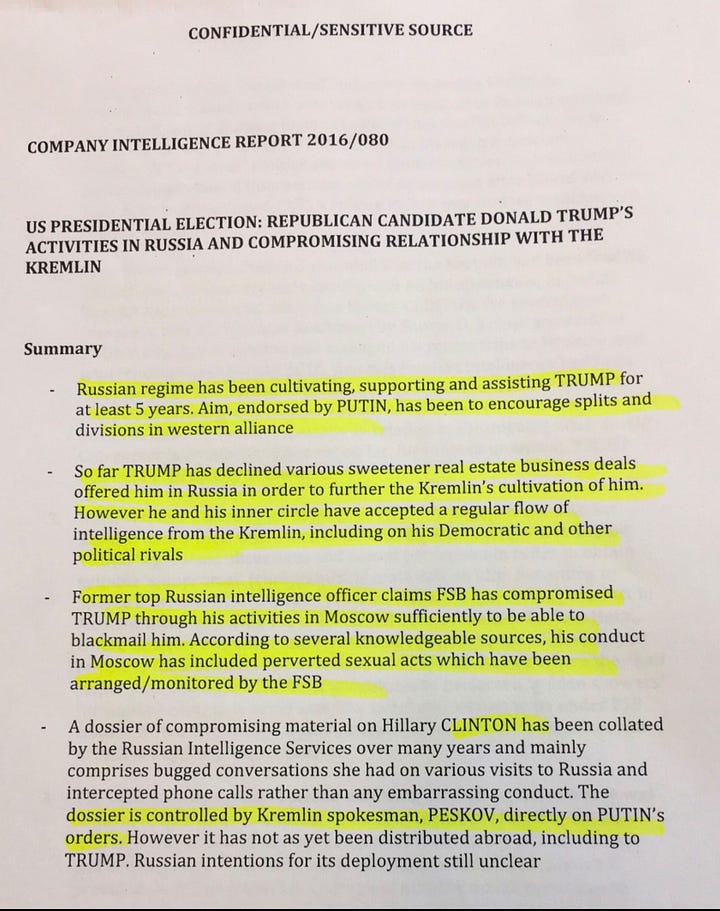
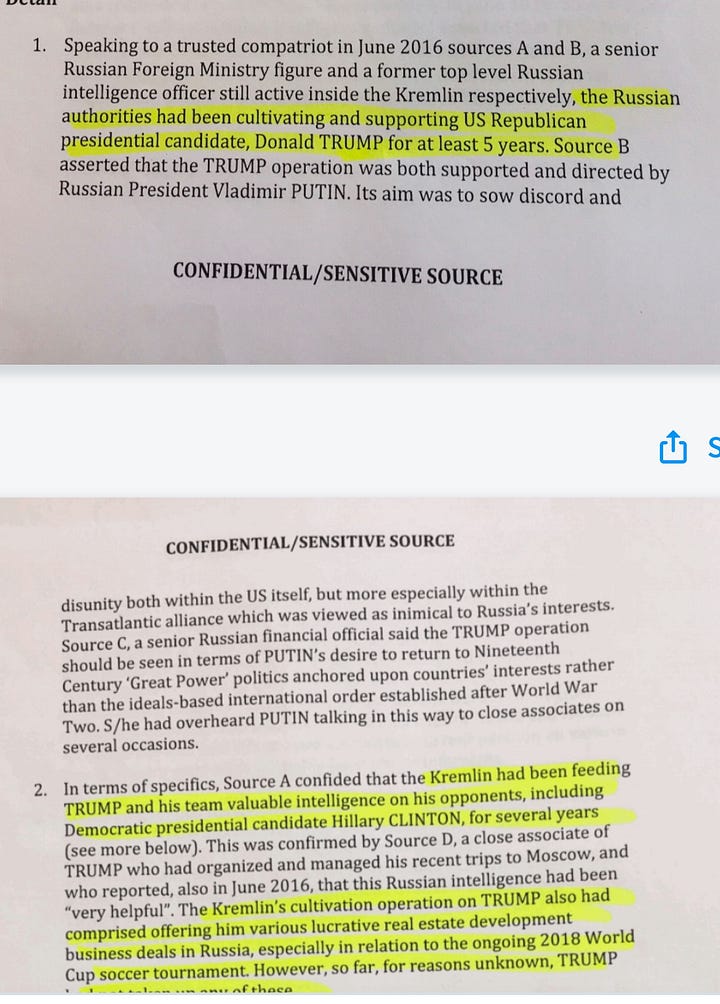
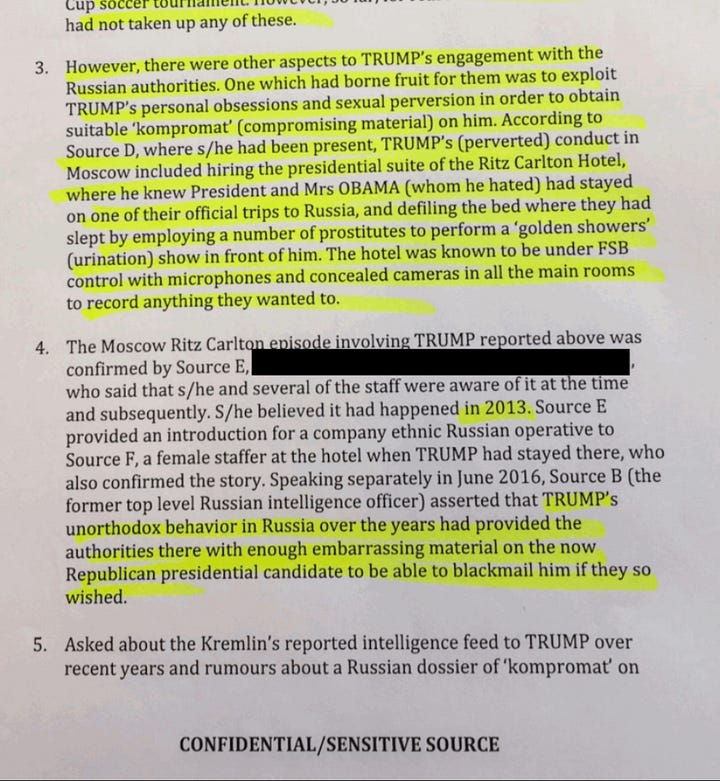
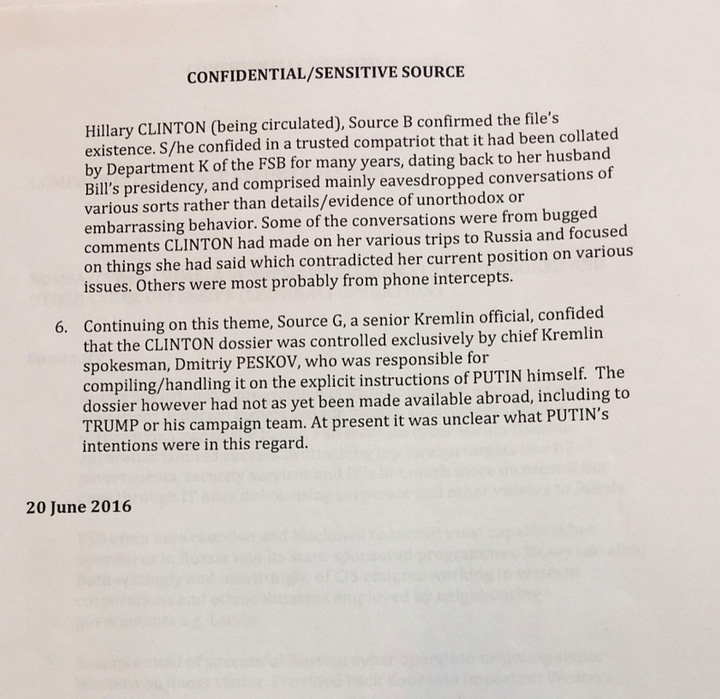
The dossier was bogus, an artifact of exaggerations, lies, and smears, advanced by suspicious characters, including a man who would be charged with (but eventually acquitted of) lying to the FBI about his claims. The document itself was perhaps a Russian disinformation effort. In the light of hindsight, even the New York Times describes the dossier as bunk, something with “no corroborating evidence…to support many of the specific claims” in the document.
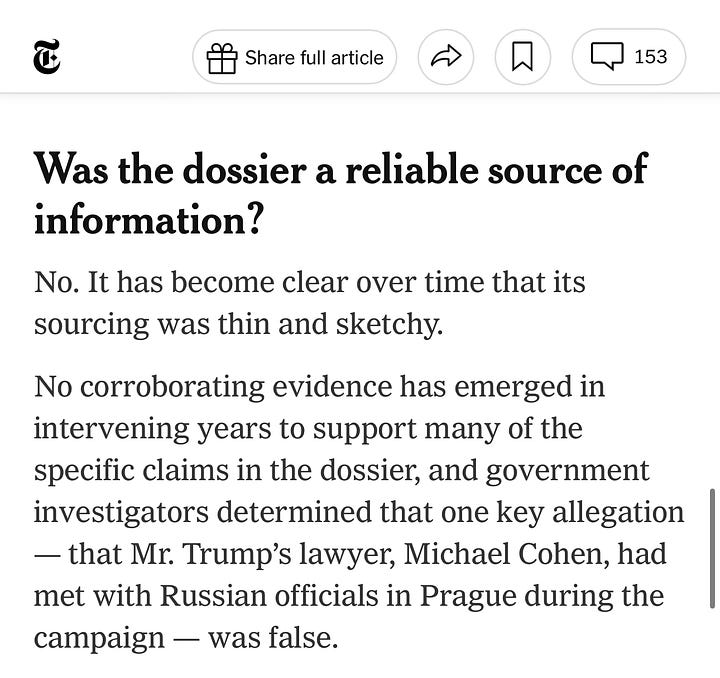
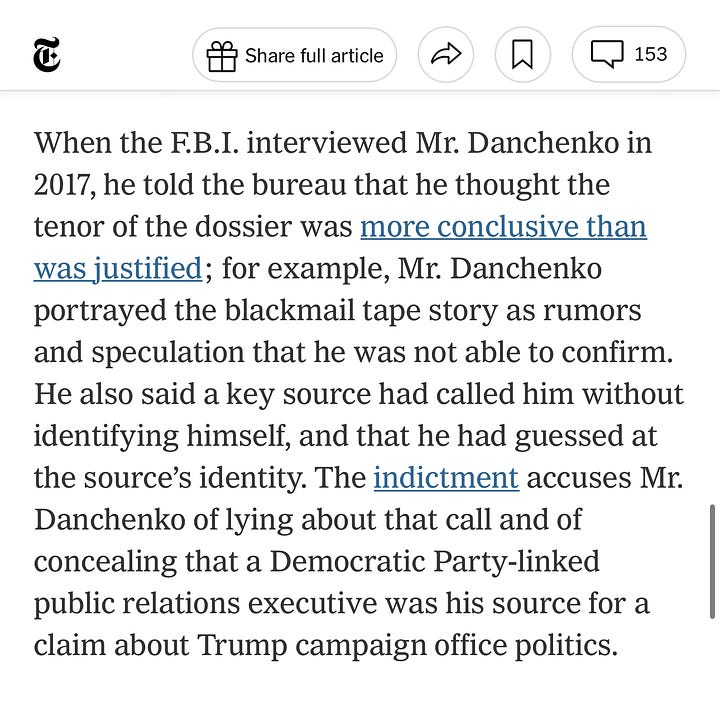
But before all that, in the early days of Trump’s first term, the bogus dossier was instead treated as the smoking gun of impropriety by the new president; something, if not gospel truth, that was at least not unproven, and clearly pointing to him being in bed (literally and figuratively) with our chief geopolitical enemy, Russia. It was laundered through the pages and airwaves of the media to create perhaps the most radical example of real disinformation: that the President of the United States might be a secret agent of the Russians, an unwitting Manchurian candidate or perhaps a sleeper-cell spy, working not just to subvert democracy but subjugate America to the Kremlin.
As recently as 2022, nearly half of registered voters said they think that President Donald Trump is compromised by the Russians, including 72% of Democrats — despite all the investigating, from Mueller and others, failing to provide evidence of that, the actually damning evidence always just out of reach.
It all got its start with the Steele dossier, the first media talisman of the Trump era.
The coverage:
You may remember the ethos of the coverage — the media’s credulity about an explosive if entirely uncorroborated piece of dirt on Trump, whose shocking electoral victory had unmoored the press. But I want to take you through some of the specifics — a couple in greater depth — to try to capture just how far outlets went to try to transform this entirely unverified piece of oppo research into a narrative to undermine an incoming administration; without even bothering to verify the information they were gleefully repeating to Americans who rely on them for the truth.
Given their concession cited above, there’s nowhere better to start than the New York Times. Despite acknowledging the document was both “sensational” and “unverified,” the Times put three authors on a byline to walk through the story’s entire history, and rather than say that parts of the story might just be invented, they described what wasn’t known as “out of reach” and still a “glimpse of the hidden side of presidential campaigns.” That without bothering to get to the bottom of whether what they were relying on was legitimate.
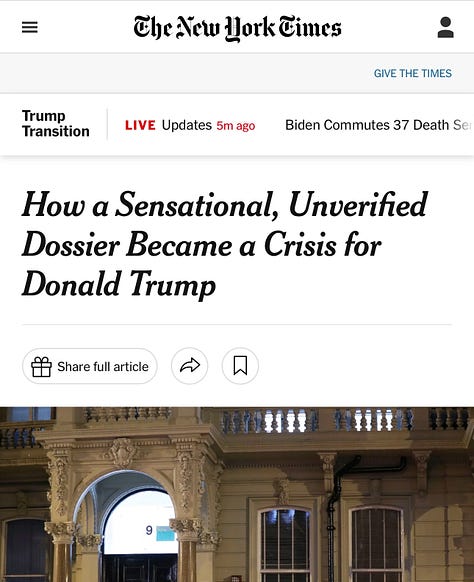
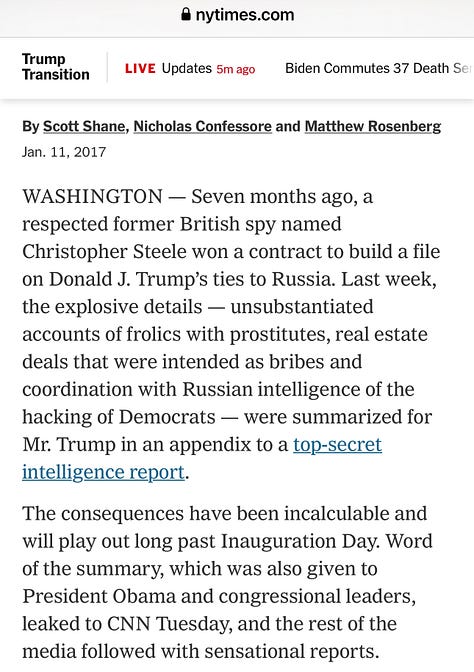
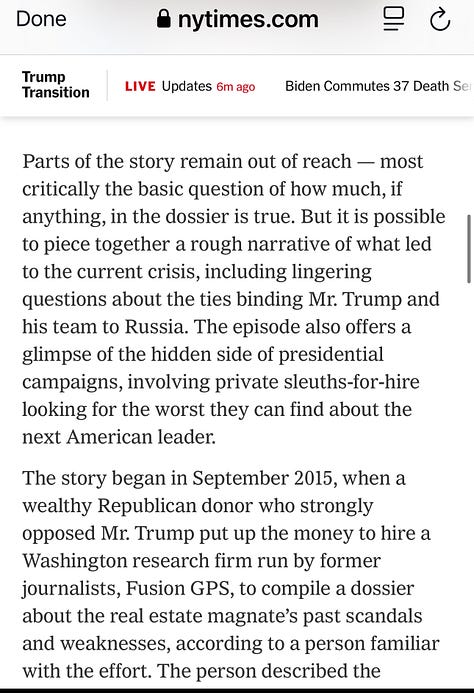
From there, the piece gets much worse. The Times hypes up Steele, who supposedly “has an excellent reputation” and went on to repeat the worst of the claims against Trump, without any evidence that they were true! The memos described Russia using an array of tactics, including, allegedly, “tapes of Mr. Trump with prostitutes in a Moscow hotel,” and the idea that Trump could be a “source who might provide information to friendly contacts.”
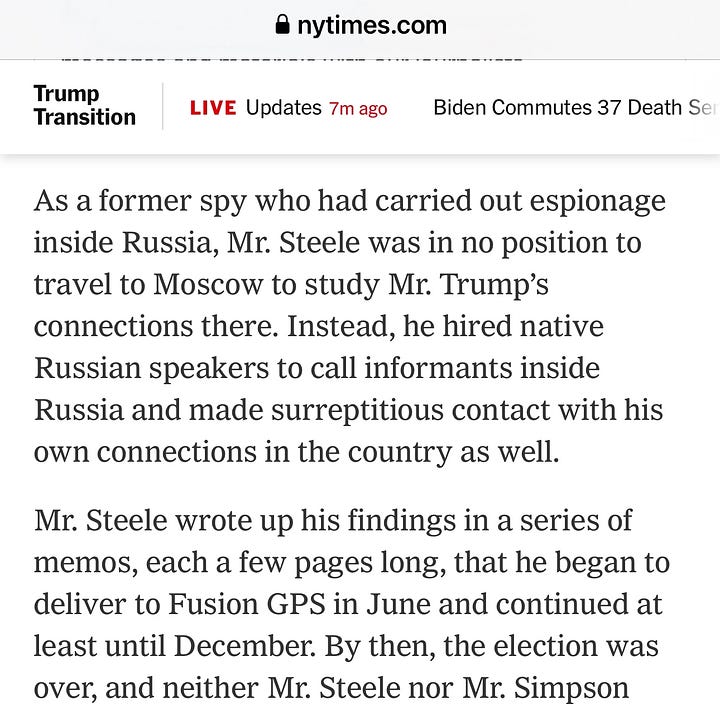
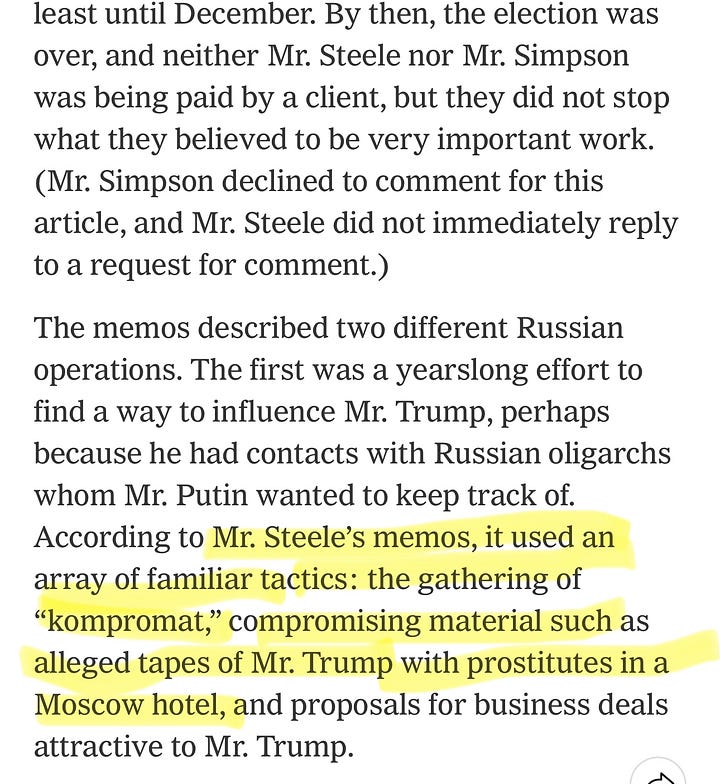
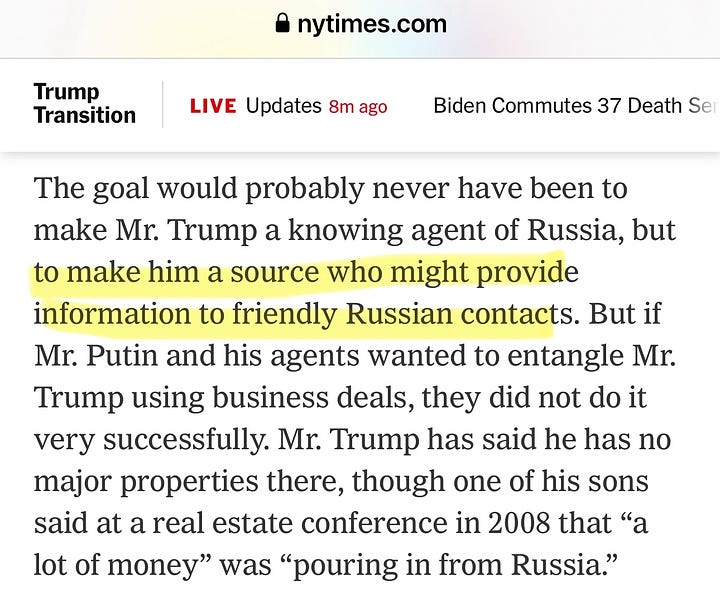

It should go without saying, but simply putting these conspiracy theories out into the universe helped give them legitimacy, without the Times bothering to figure out the veracity of any of them. The insinuation was lethal enough. This is why journalistic sourcing and verification is so important: because you don’t want to spread things that aren’t true. Where was that discipline here?
In other stories, at least the New York Times made a habit of repeating that the allegations were unsubstantiated—even if they did seem to imply that perhaps Trump’s new admin was going to try to hunt down Steele (the bar here is low, and about to get lower).
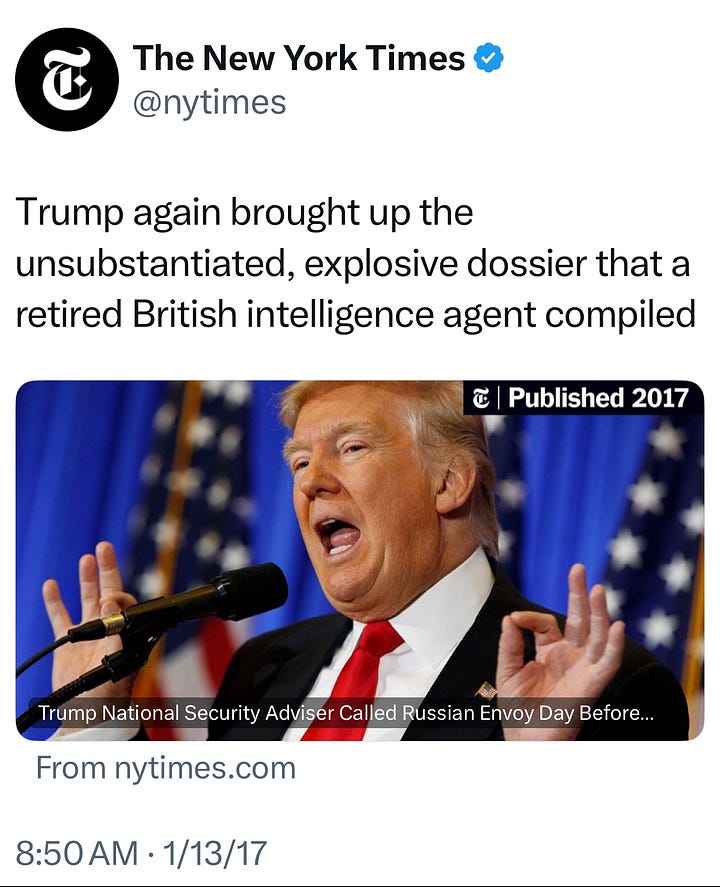
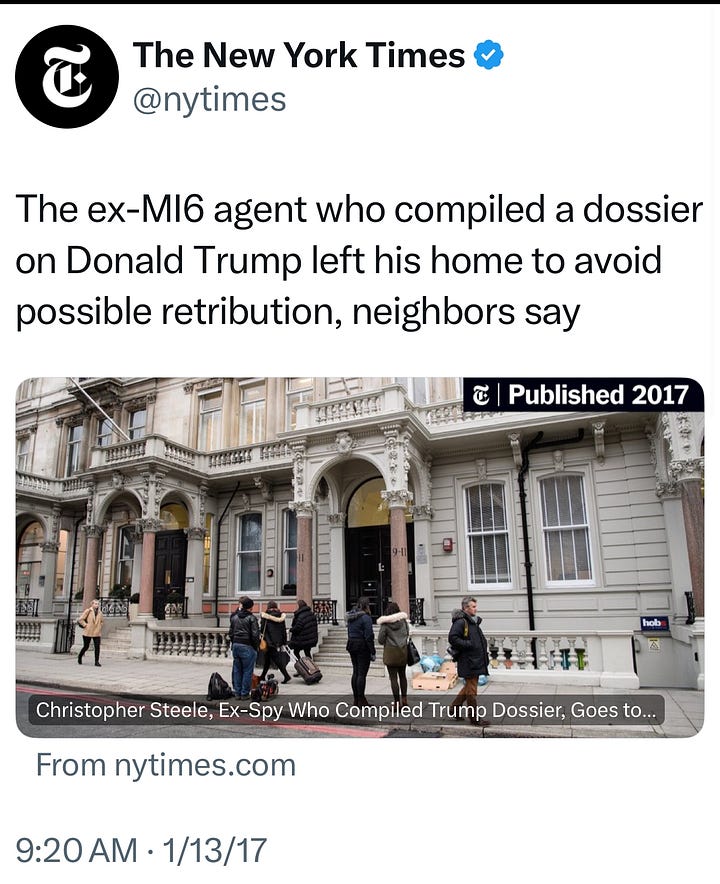
Other outlets weren’t so scrupulous.
Perhaps no outlet has more egg on its face as a result of the dossier than the Washington Post. Sometimes the retractions (they wrote a whole story about these retractions!) really do tell the whole story.
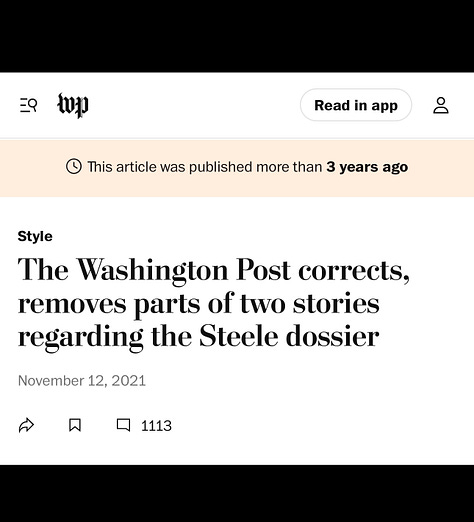
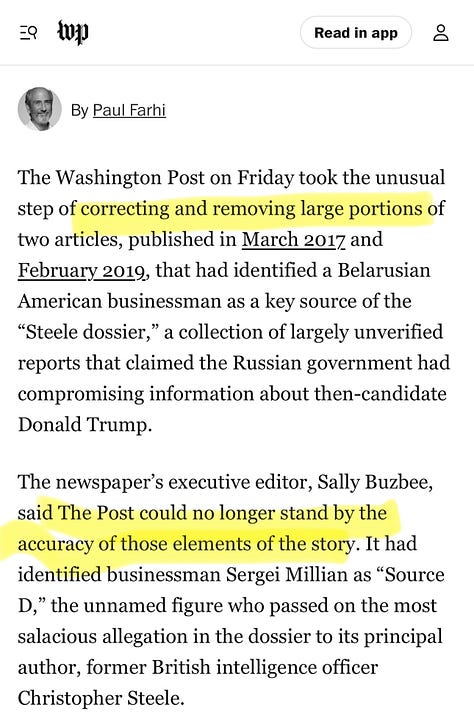
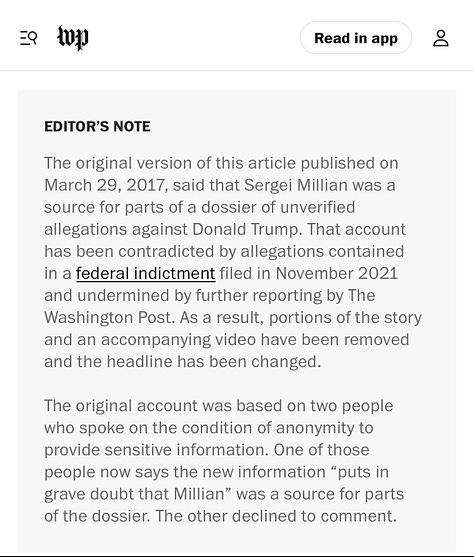
But there were other examples at the Post. There was no way I could just omit a Post story about Steele when the first word of the title is “Hero.”
What came after was often worse, and makes abundantly clear which side of that debate the Post was on. While the Times could’ve been substantially better about hedging what wasn’t known, the Post went all the way to just repeating allegations whole-cloth without even qualifying them as unverified: “The Russians had damaging information about Trump’s personal behavior and finances that could be used to pressure the GOP nominee.”
Steele was a “peer” of U.S. intel, someone who “had all the right credentials for the job,” the Post said. What job, exactly? The right guy to plant a conspiracy in the media? And do we really need a description of his “greying coif and tailored suits with cuff links”? Was there a need for all this fan fiction?
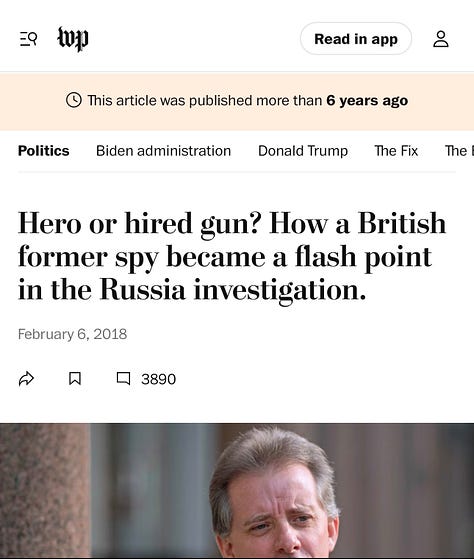

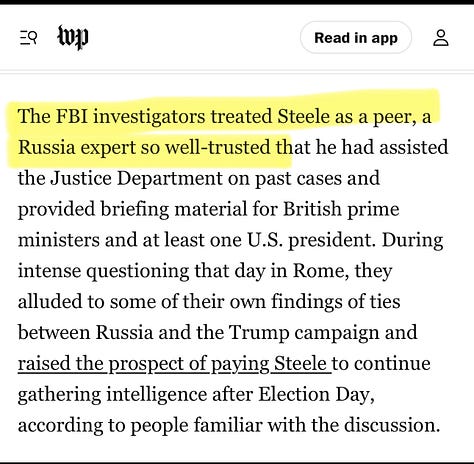
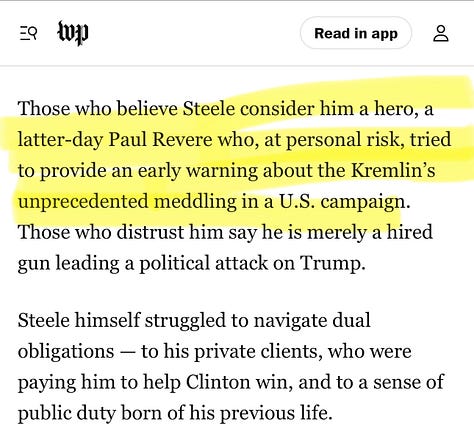
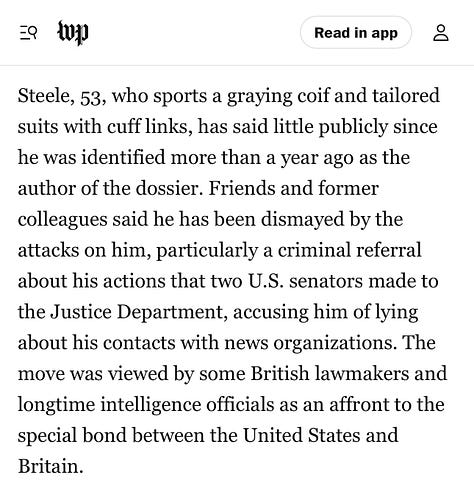
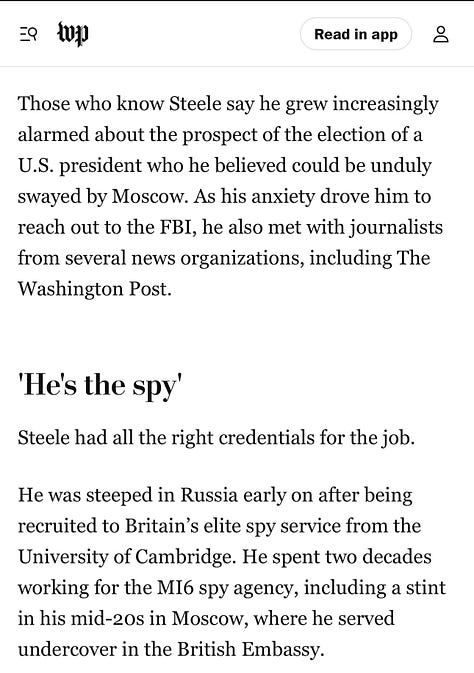
The journalistic failings here horrifying.
On the network side, CNN was one of the most rabid promoters of the Steele dossier. A couple pieces stand out. The first typifies the media’s coverage; sure, we didn’t know everything was true, but not everything was false! The unspoken implication was clear: if some of it checks out — even if those details are trivial — the rest may check out, too. Maybe Trump really is comprised by or working for the Russians. Oh and “not all leverage needs to be salacious in nature,” they cried (what does that even mean??).
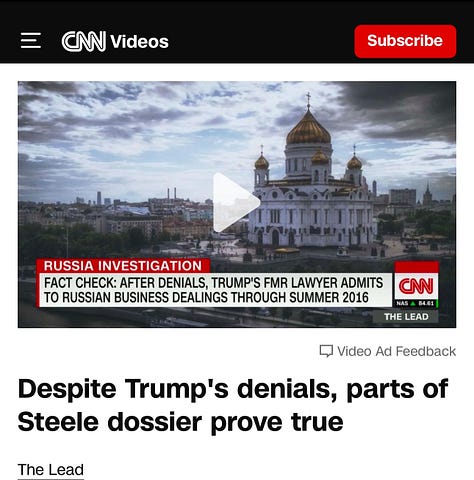
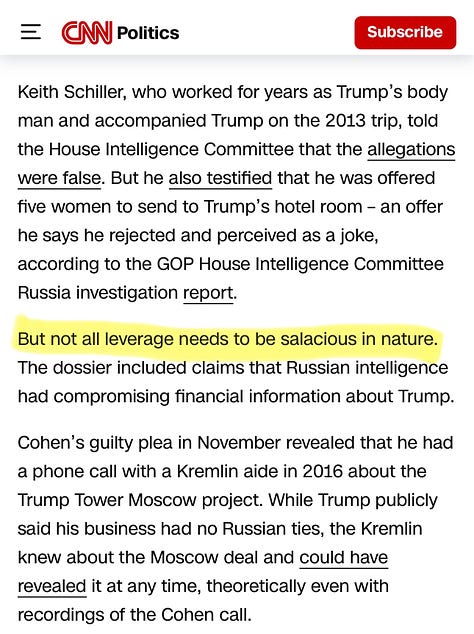
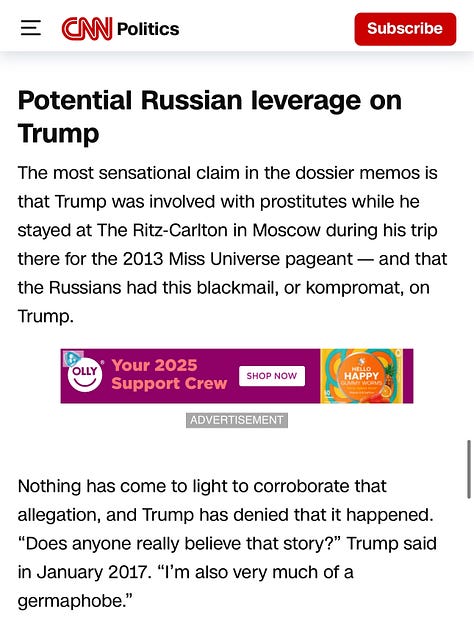
And as ever, there was the call-back to authority. Our intelligence community is concerned. Jim Comey is concerned. They of course can’t say everything they know, but doesn’t it scare you that they’re scared?
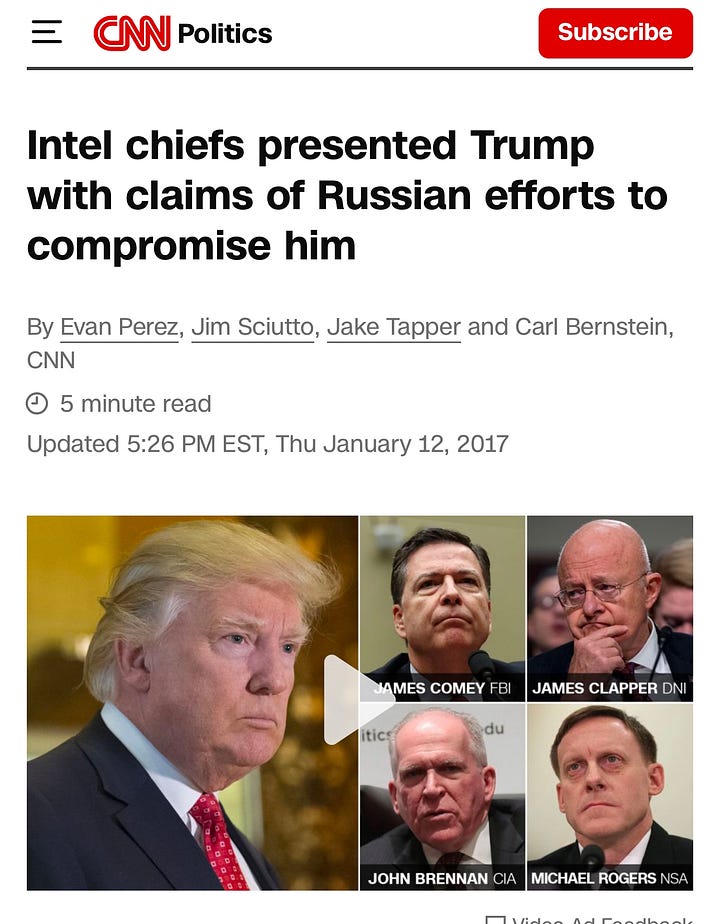
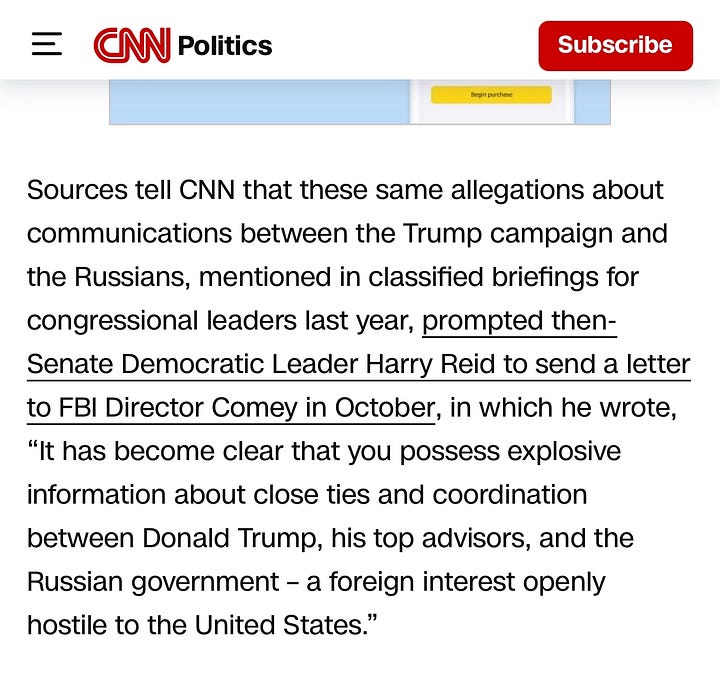
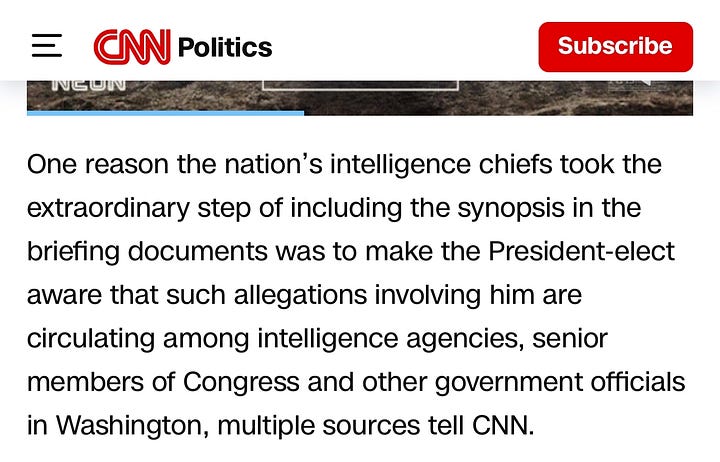
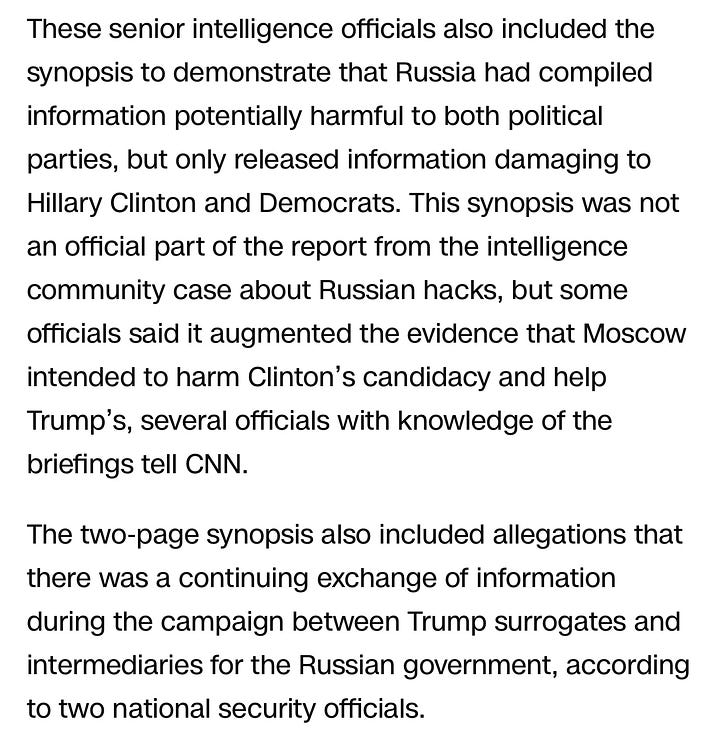
A few months later, CNN one again tried to imply that there was something very nefarious going on here — even if we couldn’t confirm the salacious details, that is.
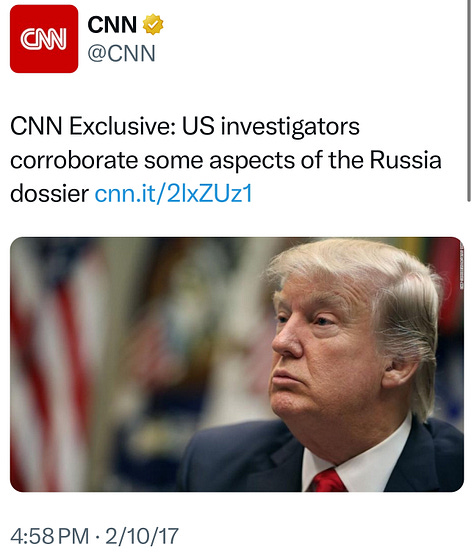
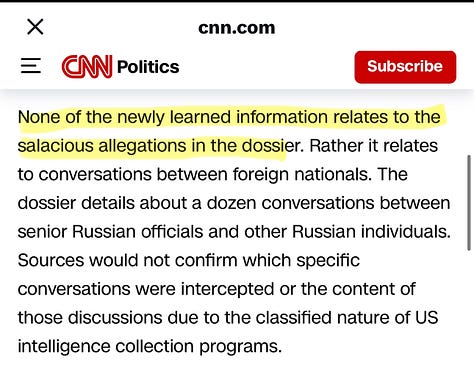
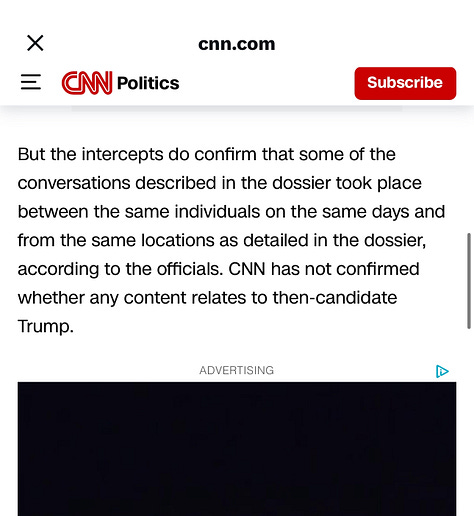
Even Mueller was interested! Trump had to be wrong to say it wasn’t real!
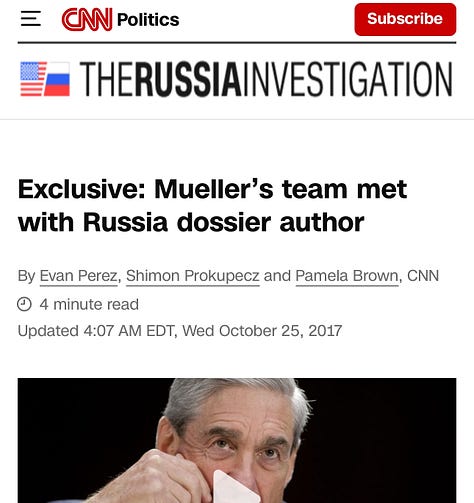
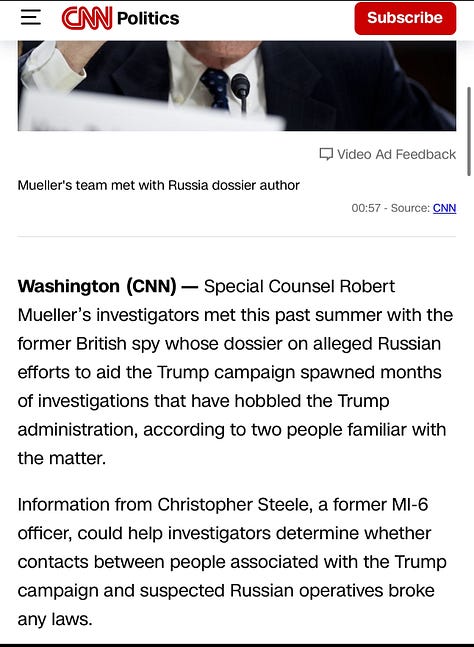
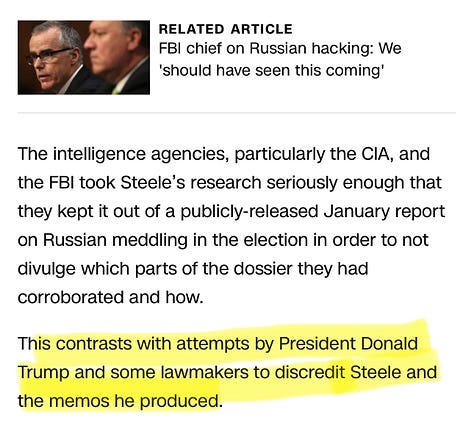
This notion quickly became a rallying cry at the network. Voices from across CNN were among the leading promoters of the document as “part true” or thereabouts, including hosts Jake Tapper, Erin Burnett, Anderson Cooper, and Alisyn Camerota (h/t Ryan Saavedra), as well as reporter Jim Sciutto and more, as well as countless guests (many of whom were elected Dems) and reported pieces.
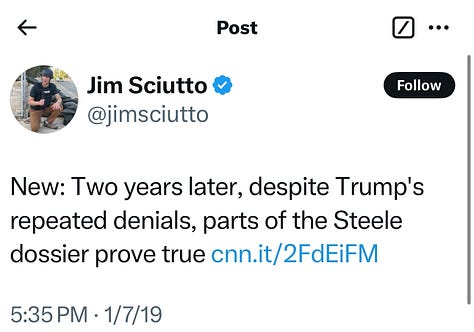
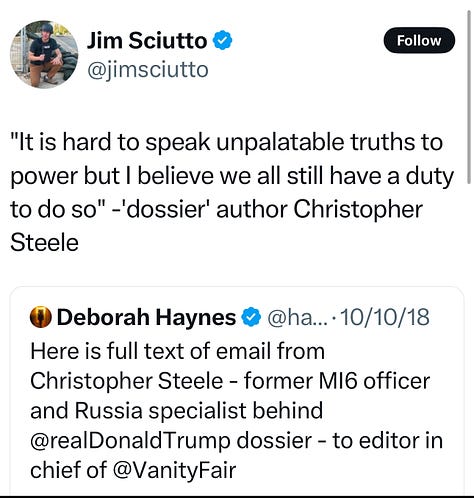
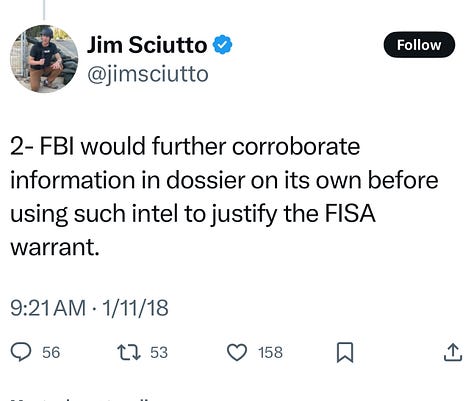
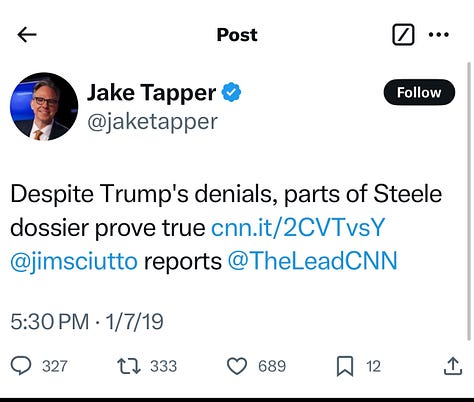
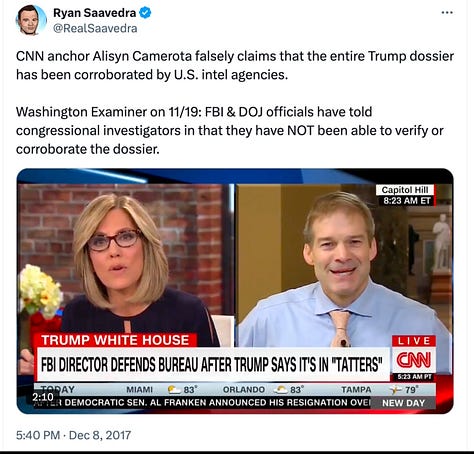
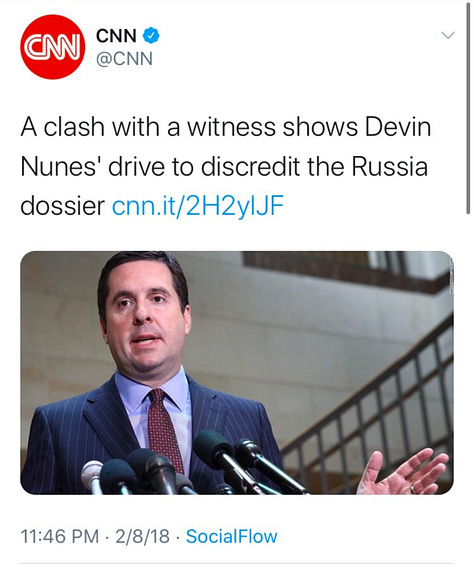
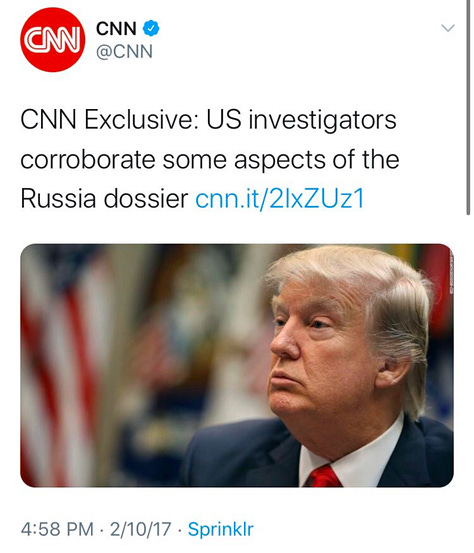
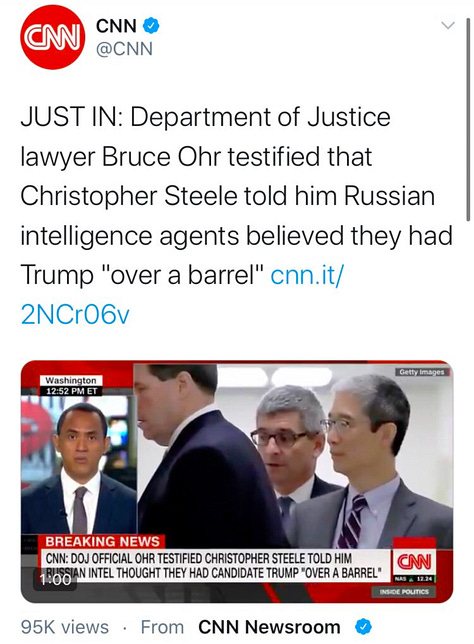
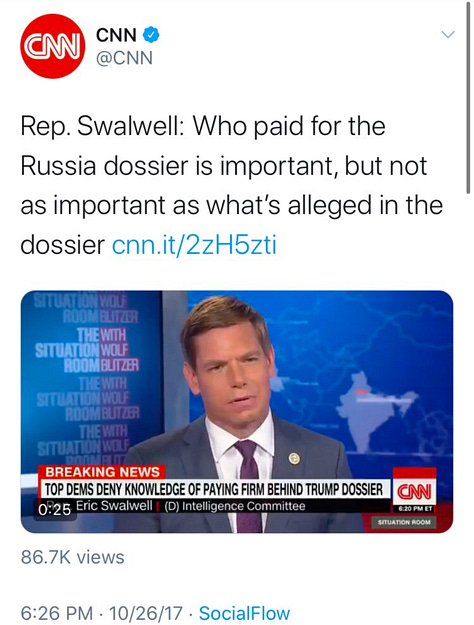
I’m limited to nine images per box. Here’s three more.
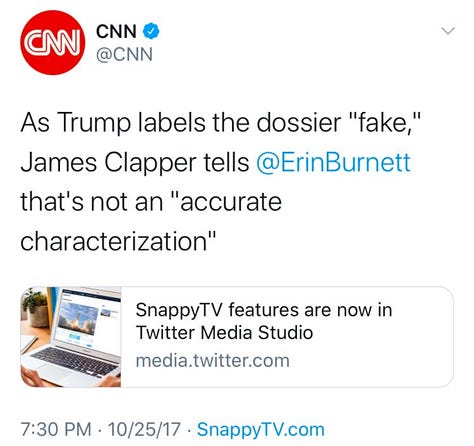
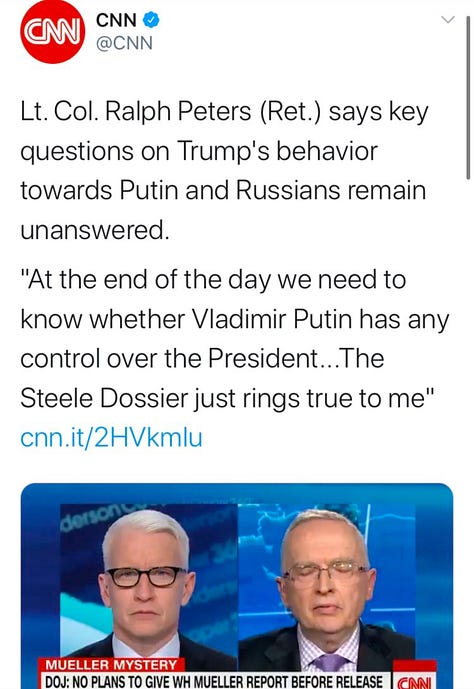
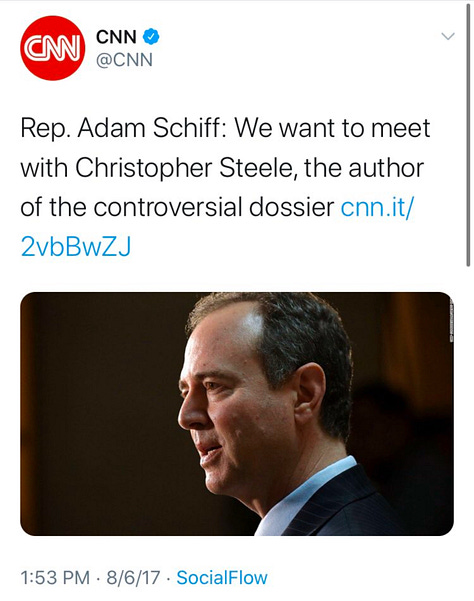
I had to give Brian Stelter his own box.
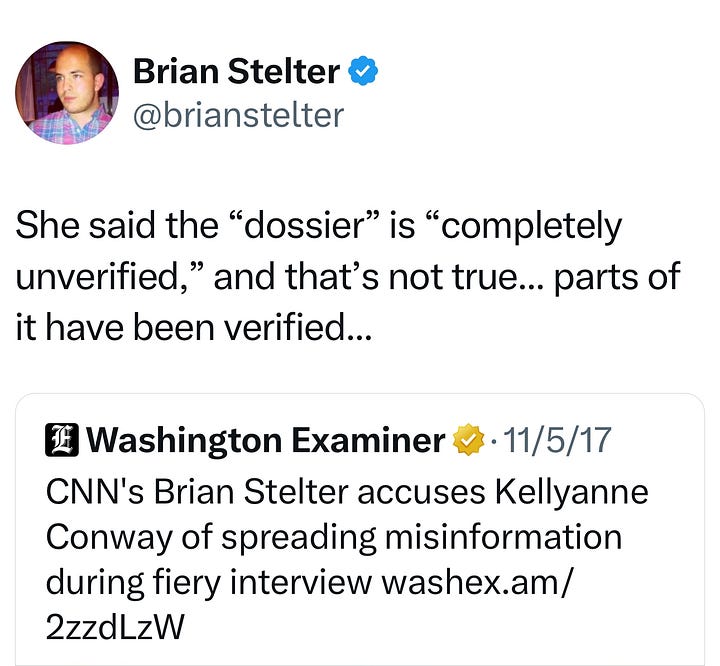
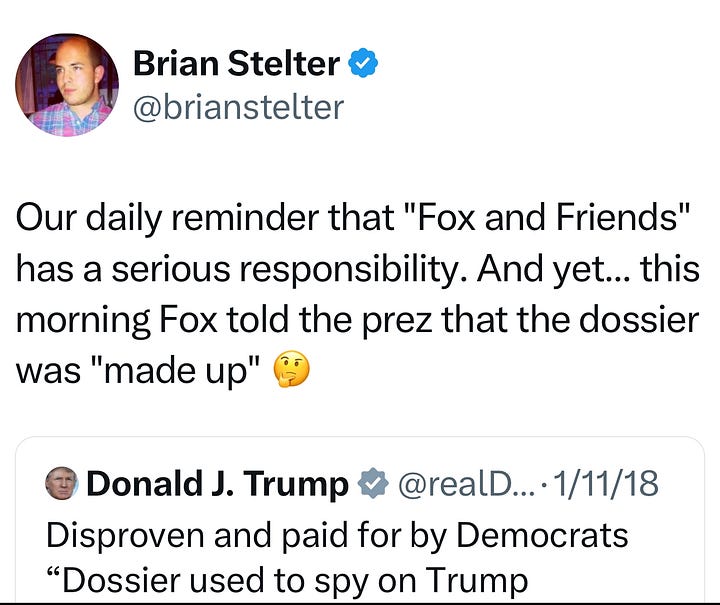
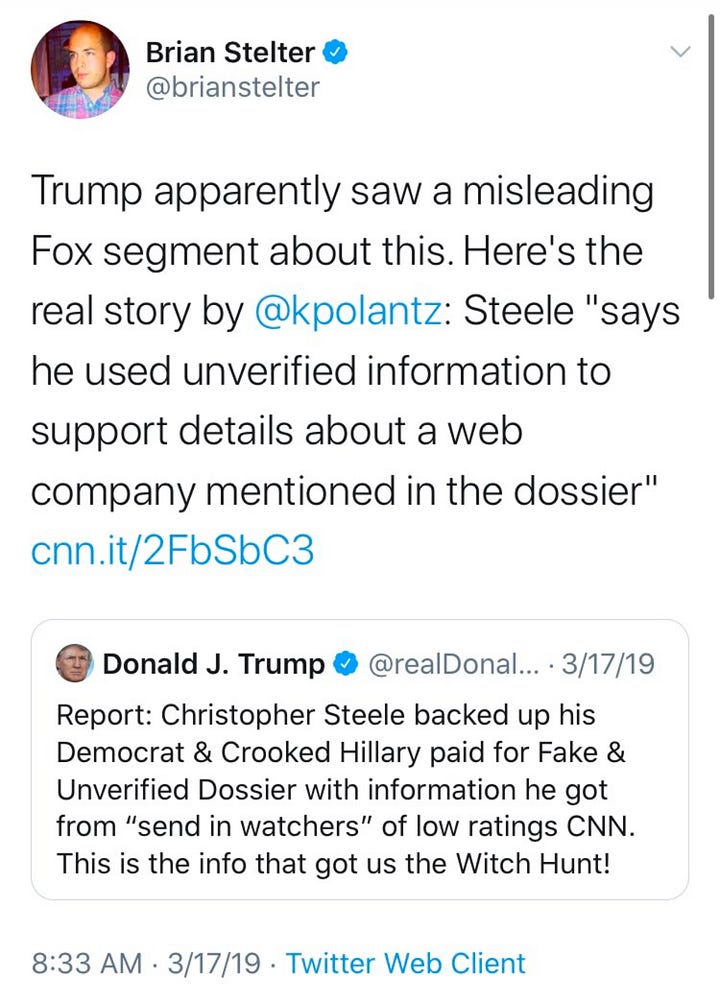
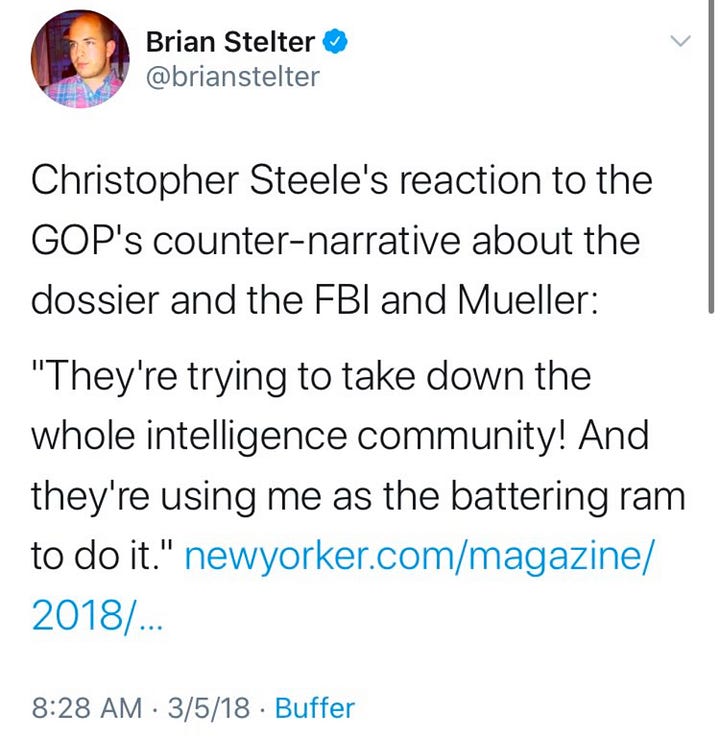
Again, all of this for a document even CNN now acknowledges wasn’t close to the hype.
But where breadth is concerned, even CNN was outdone in pushing the Steele dossier narrative by MSNBC, who dedicated more time and energy (much via host Rachel Maddow, perhaps the most committed Russian conspiracy theorist) to hyping the document.
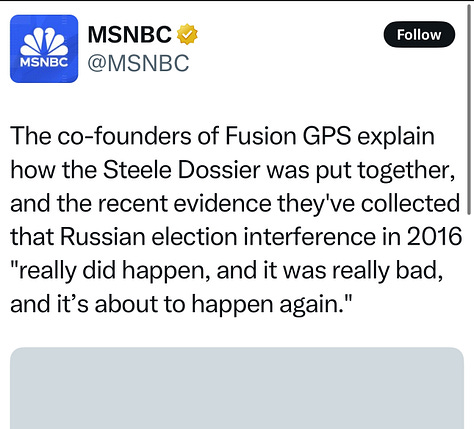
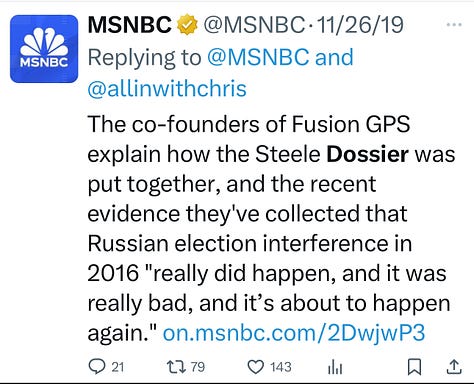
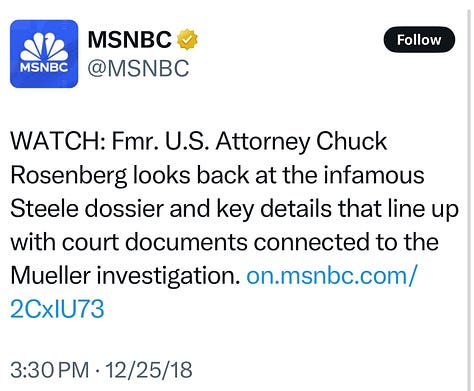
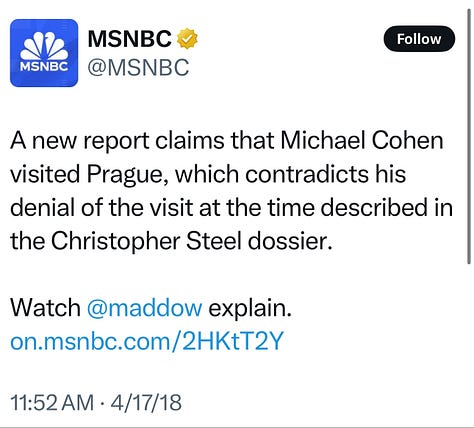
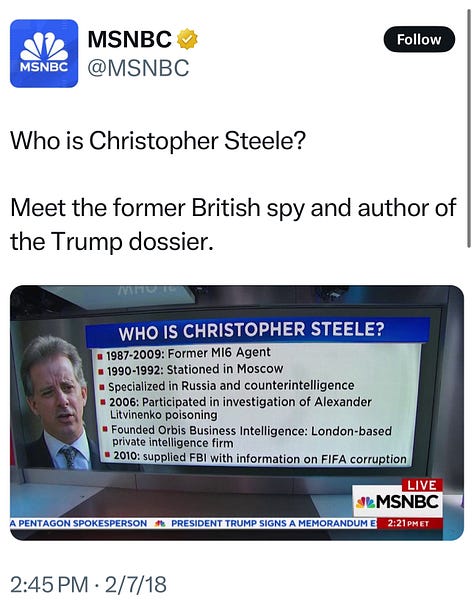
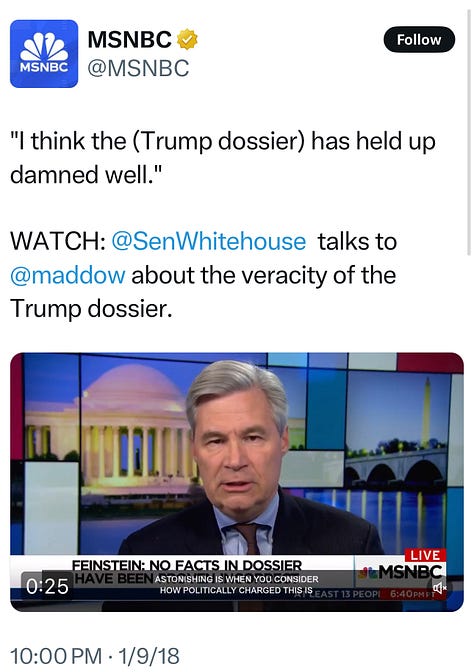
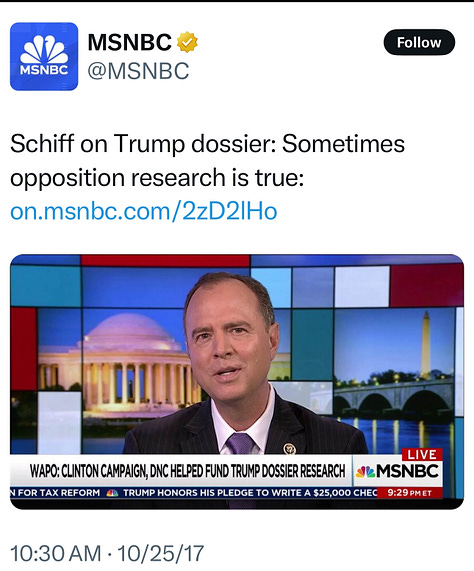
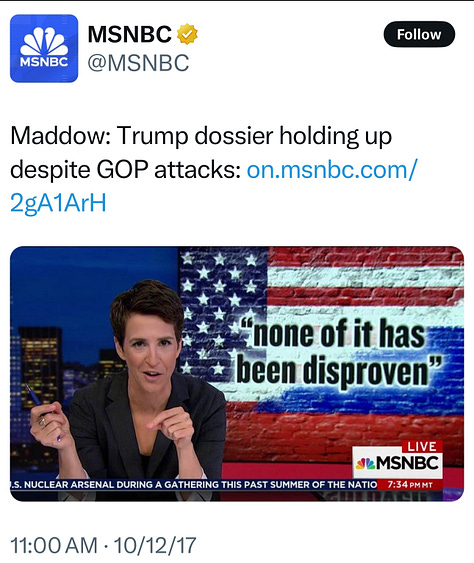
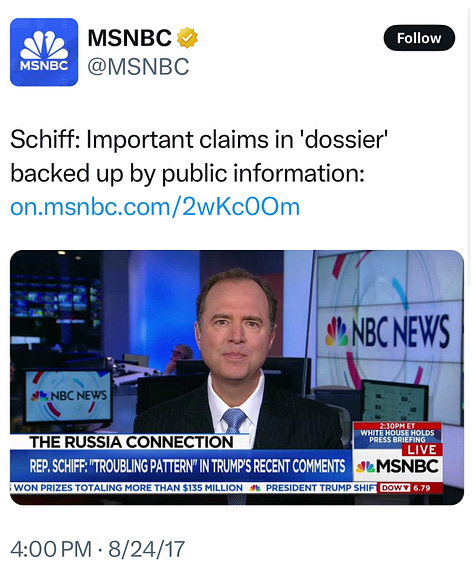
Look at all these headlines. And all these names. Rep. Maxine Waters should be ashamed of how she used her microphone during this saga. She isn’t alone.
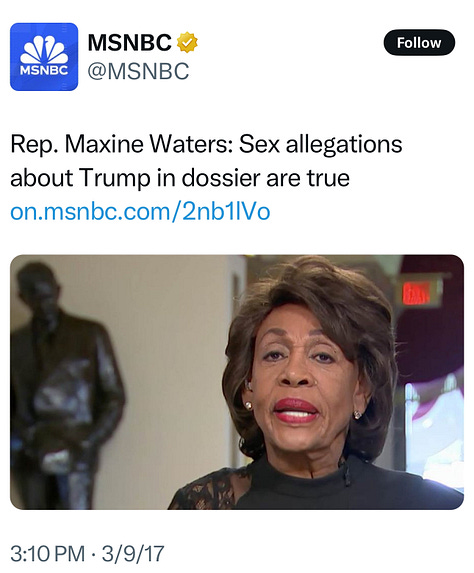
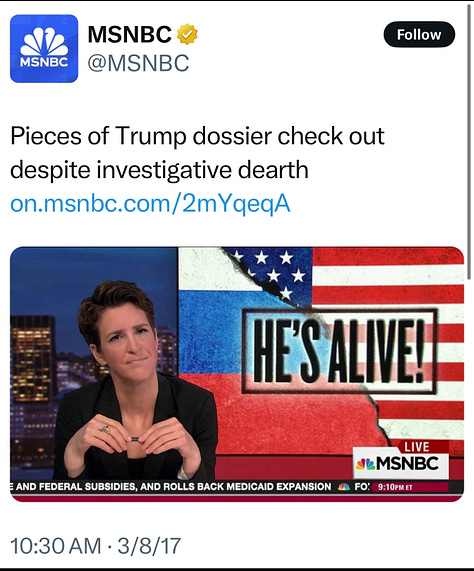
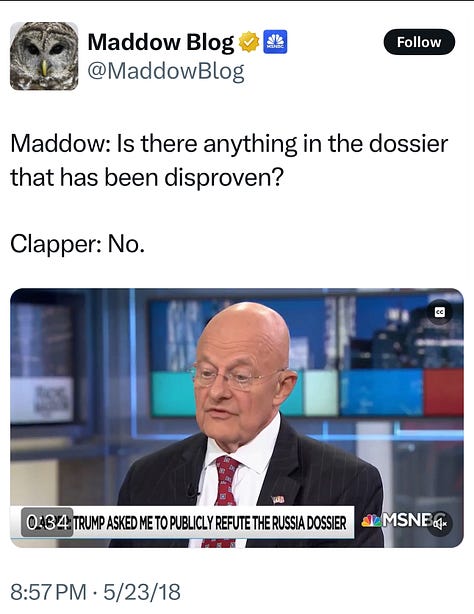
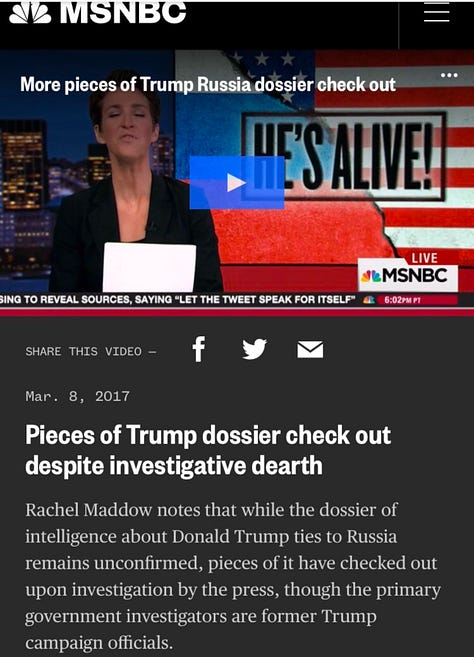

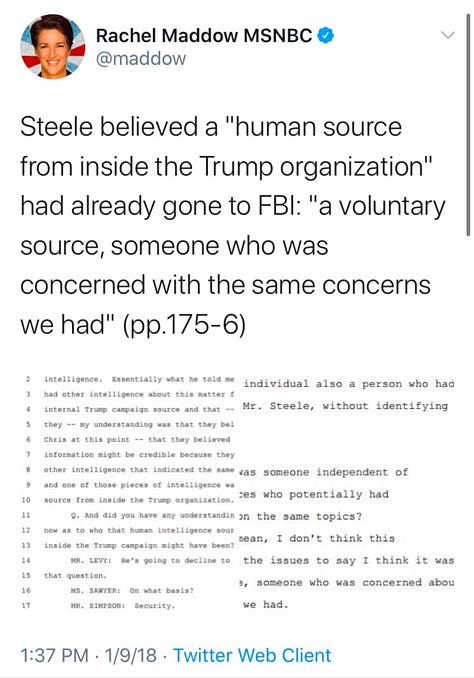
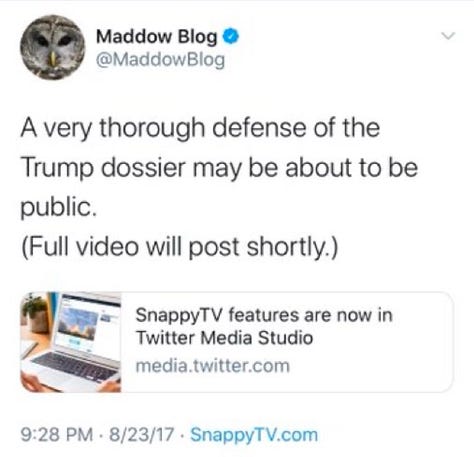
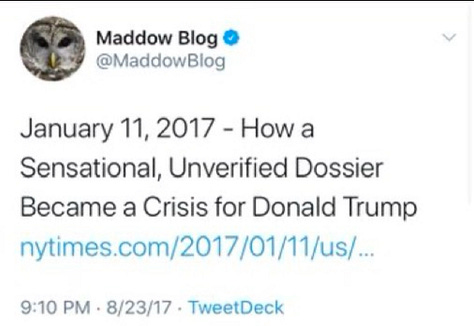

Okay a few more I couldn’t leave off. There are more I can’t fit in. An abrogation of journalism if I have ever seen one.
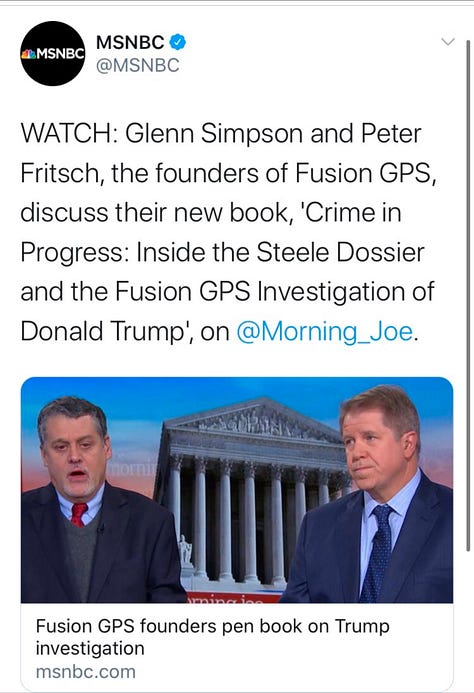
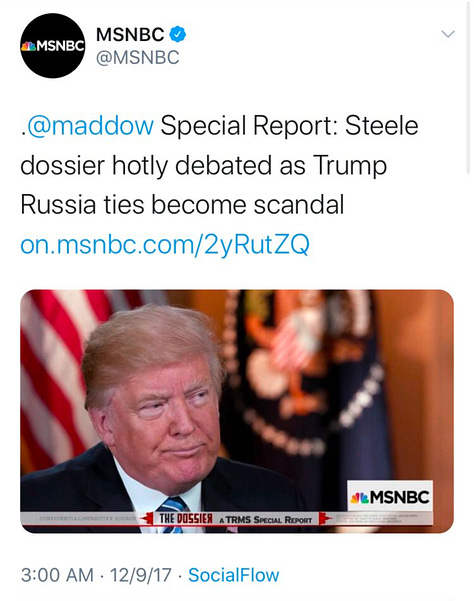
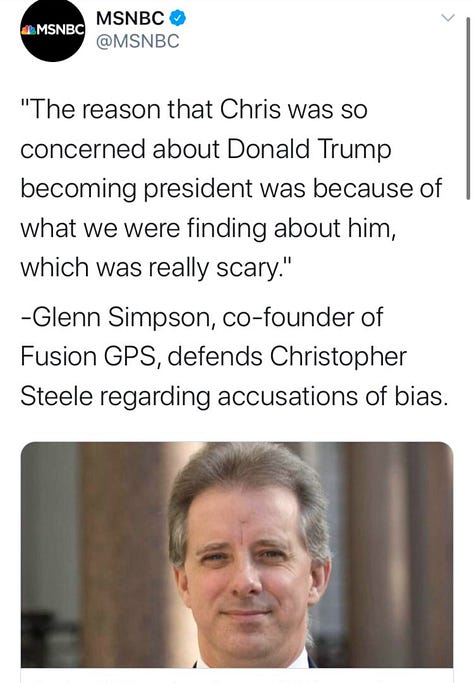
But where depth is concerned, the award has to go to Jane Meyer at New Yorker. Do you remember her cover piece mythologizing Steele, “the ex-spy [who] tried to warn the world about Trump’s ties to Russia”? Whether anything he had to say was actually worth listening to is, I suppose, another question.
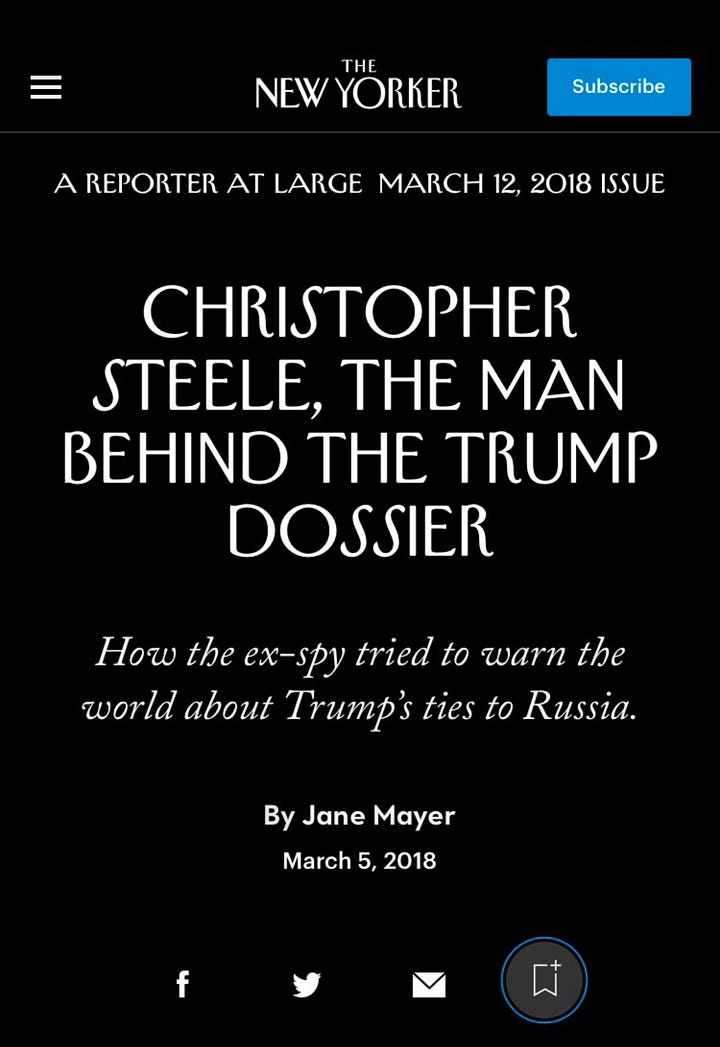
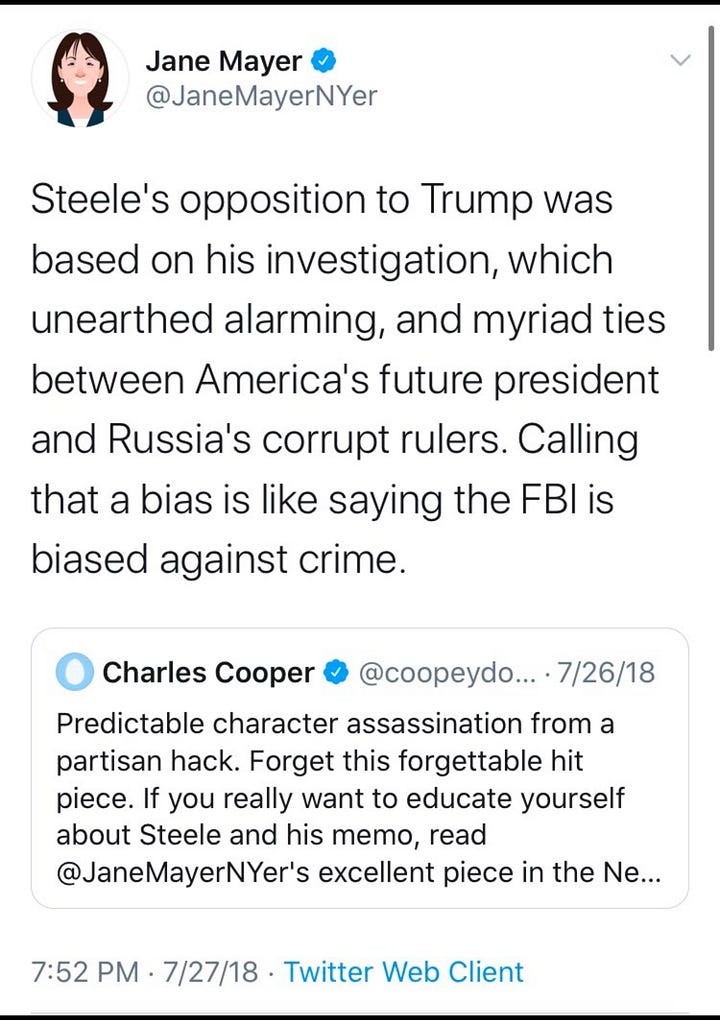
And of course, there were countless others.
NPR, despite trying to depict themselves as above pushing unverified claims, brought in seemingly every guest and review every book they could find to provide the story. Look at these highlights. “NPR has not detailed it because it remains unverified.” *one sentence break* “So where did it come from?”
You can’t make this stuff up.
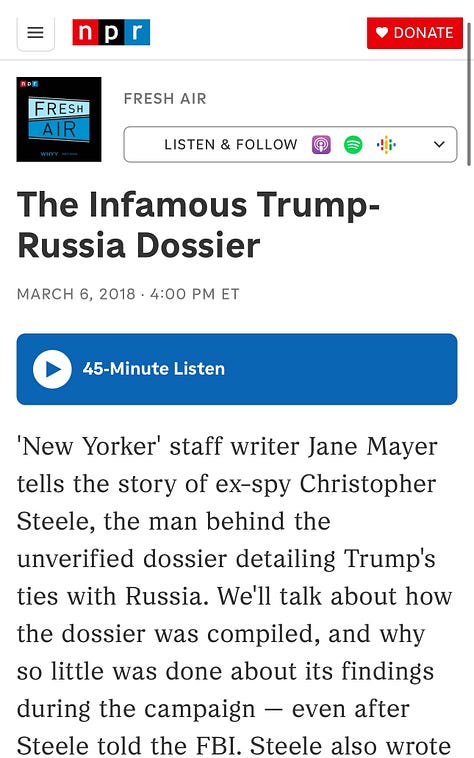
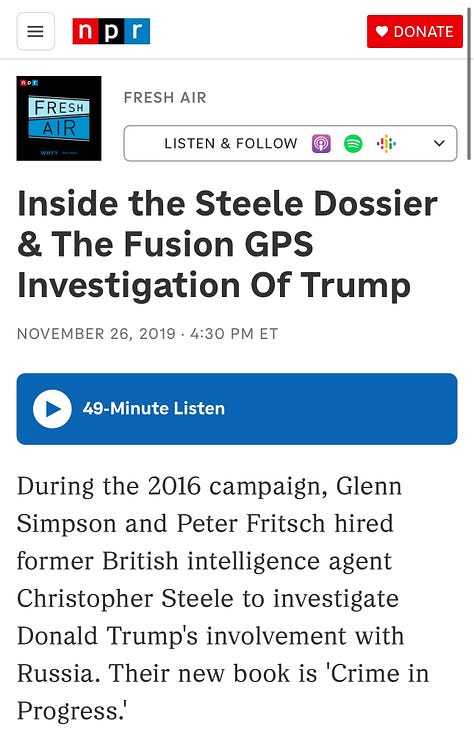
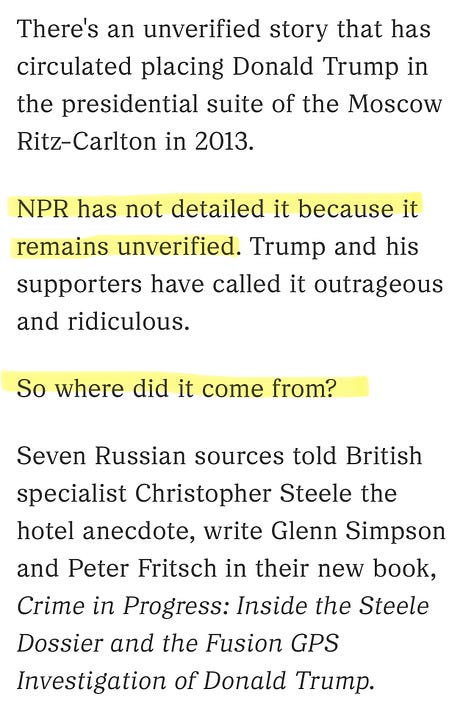
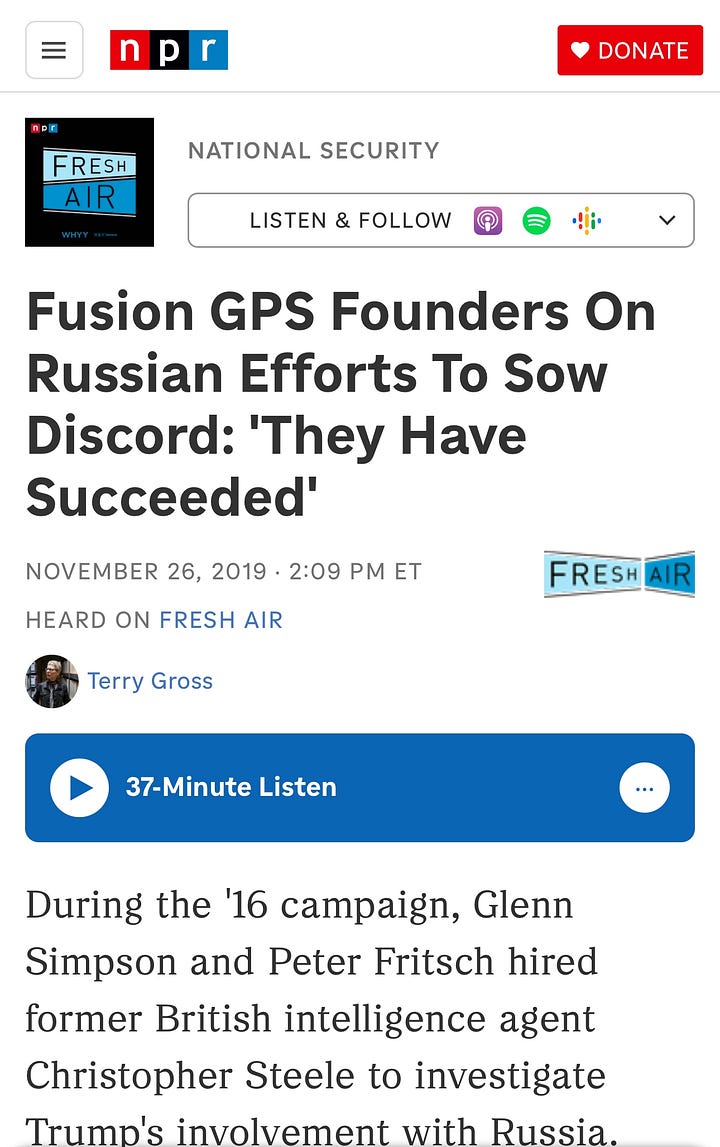
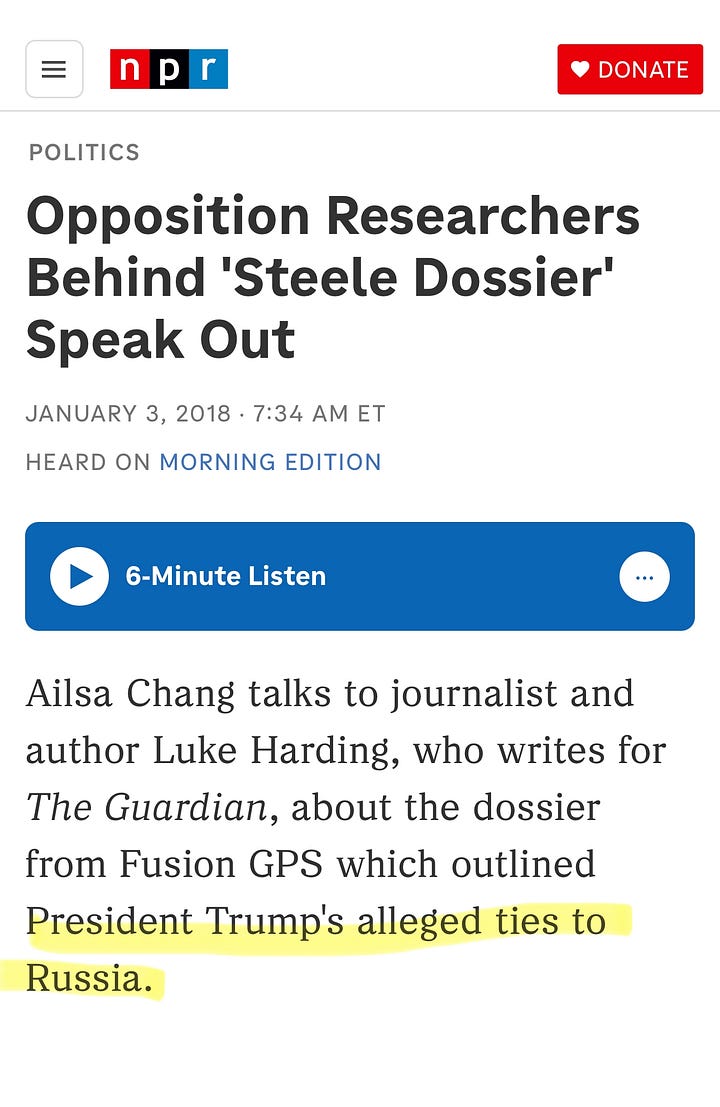
In a reported piece attempting to do the same, they quoted Glenn Simpson…founder of GPS Fusion, the company who worked with Steele to compile the dossier. I mean, cmon.
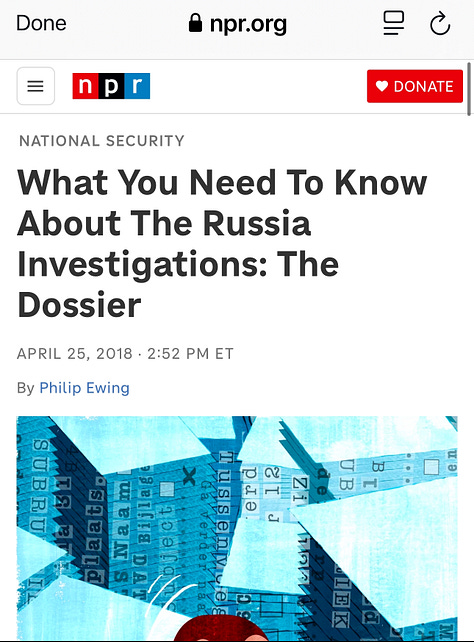
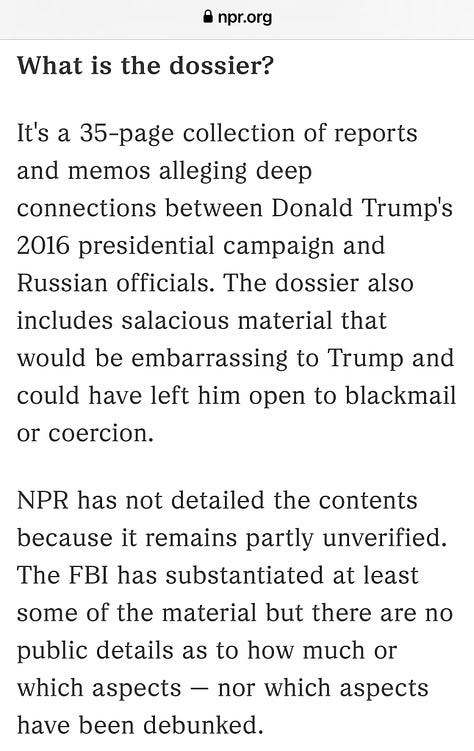
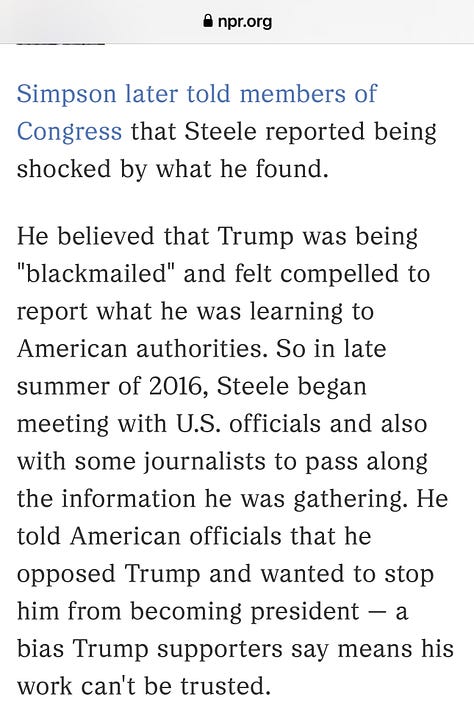
There were a number of journalists who really seemed to make it their occupational focus to push these unverified allegations. Few can rival Natasha Bertrand, then of Politico (the same reporter who kicked off the “Hunter’s laptop is Russian disinformation” narrative). “Trump was compromised by Russia” feels like a slight editorialization from a member of the media, no?
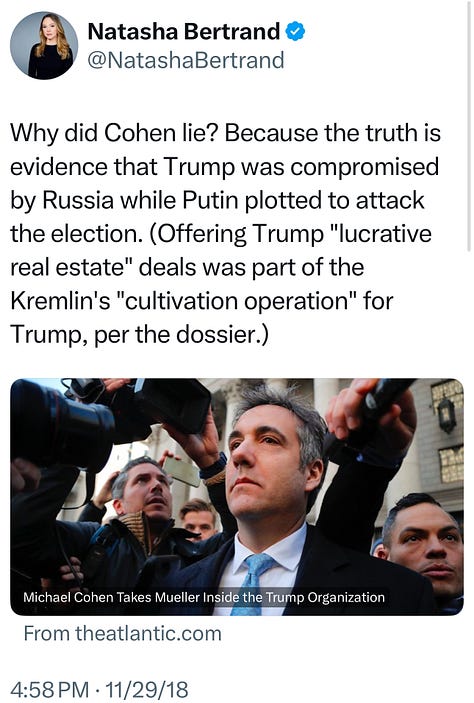
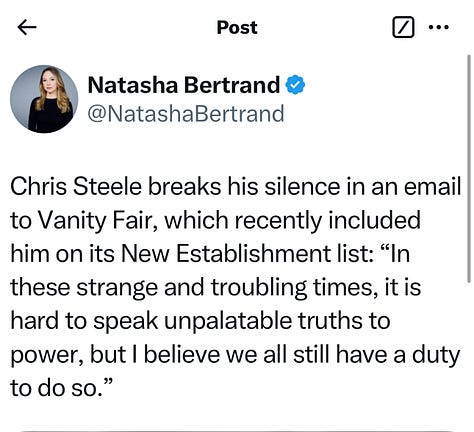
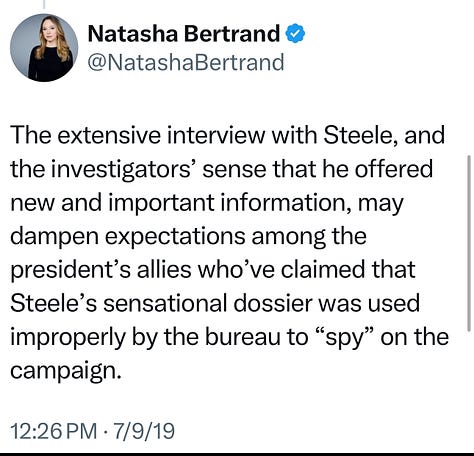
Her outlet, Politico, wasn’t too far behind, however.
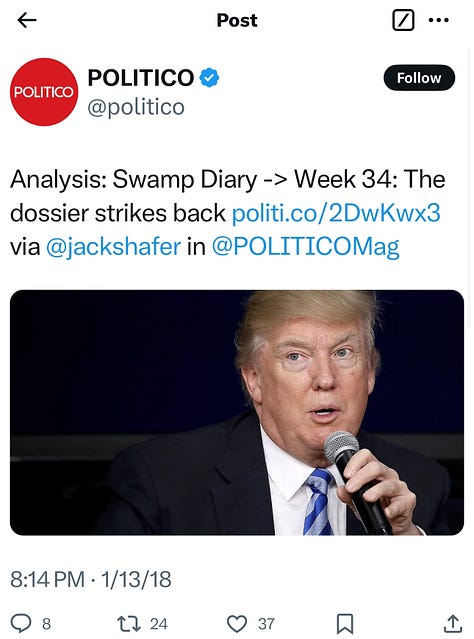

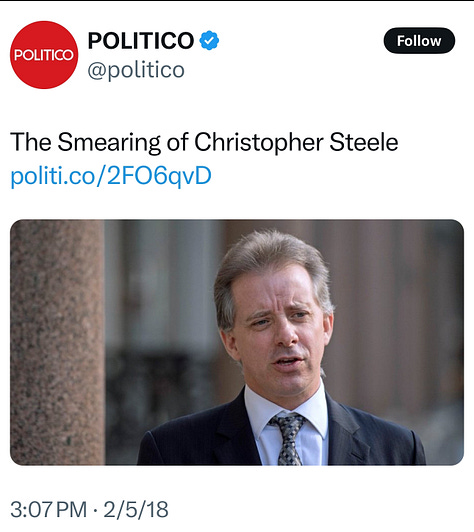
The third tweet is particularly instructive I think. Rather than treat Steele and his motives with one iota of skepticism, the press largely saw him as an innocent, honorable patriot, motivated by nothing but his desire to keep America safe.The underlying piece the tweet shares goes even further (written by a “former member of the CIA’s Clandestine Service”…make of that what you will).
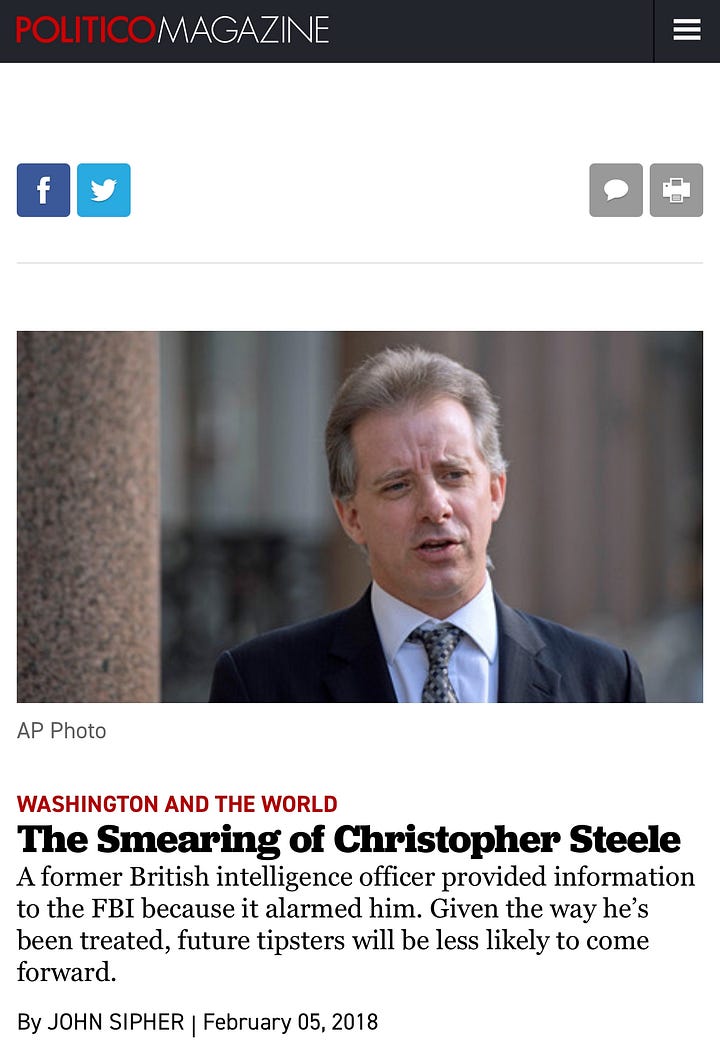
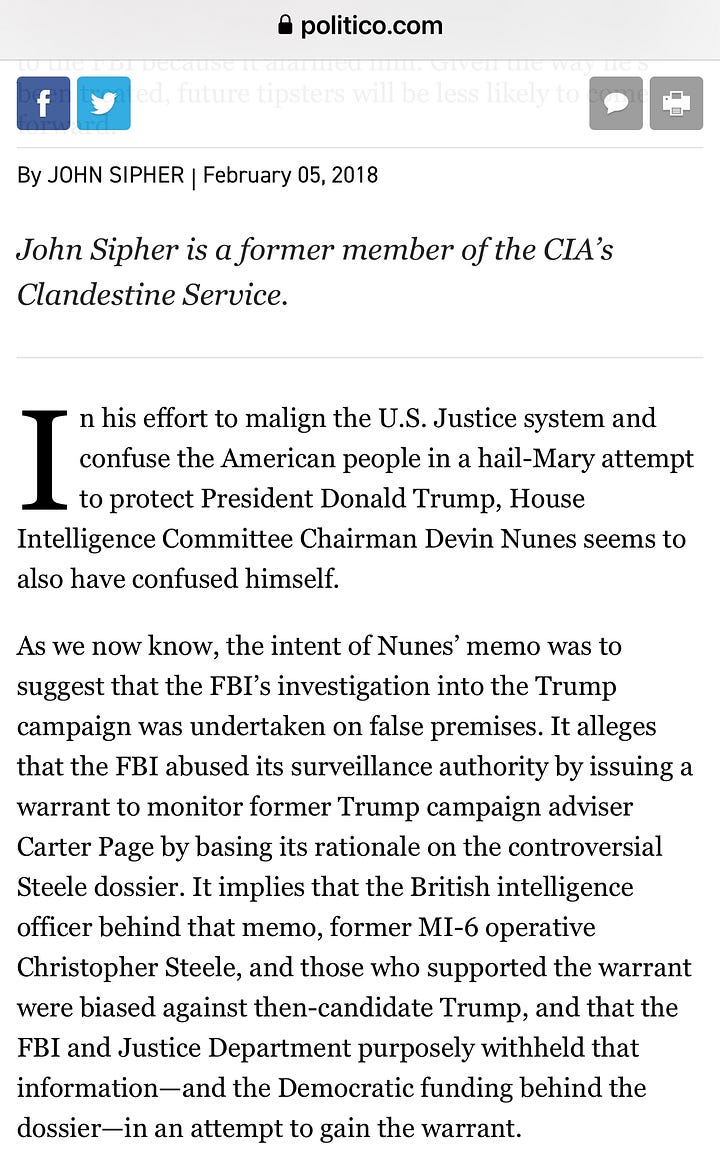
The Associated Press, as ever, was part of this false narrative. A “purported alliance” between Trump and Russia. Quite the claim!
The level of credulity applied to Steele and his claims throughout all of this really has always blown my mind. This, for someone whose role in public life was promoting something that could never be verified? Really, Daily Beast?
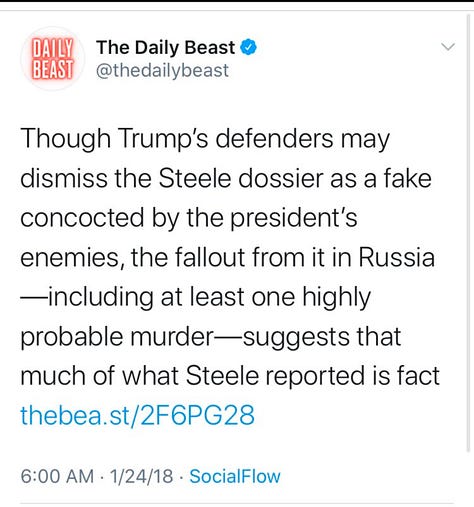
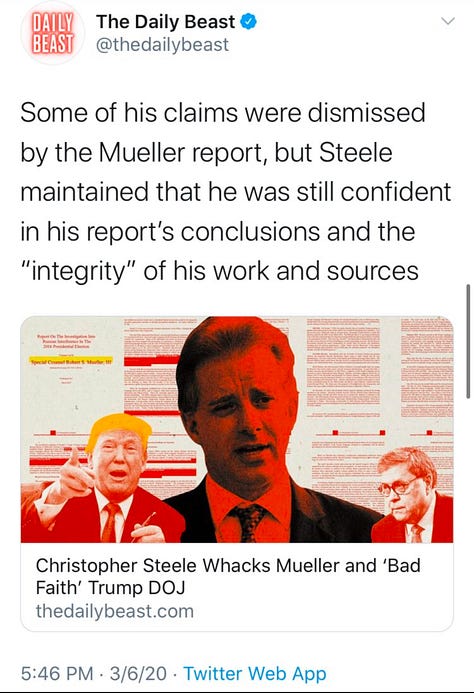
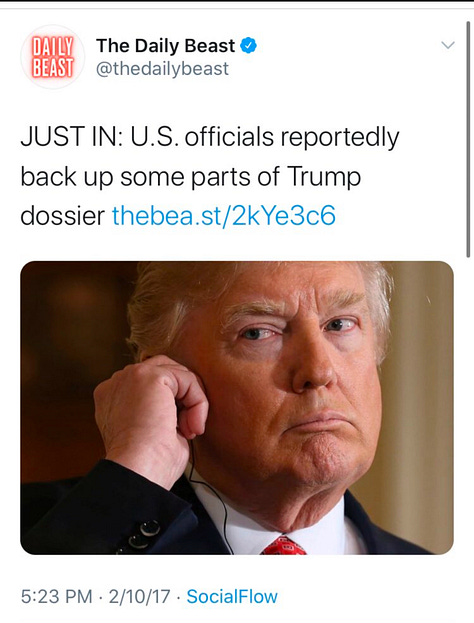
David Corn at Mother Jones was a leading promoter. Here’s just a couple. He’s still pushing it, all these years later.
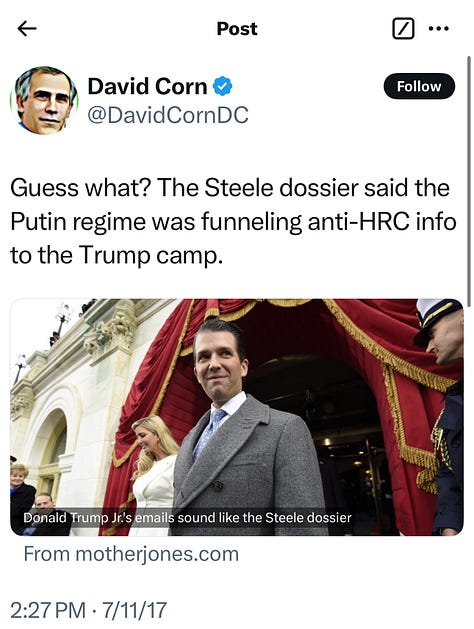
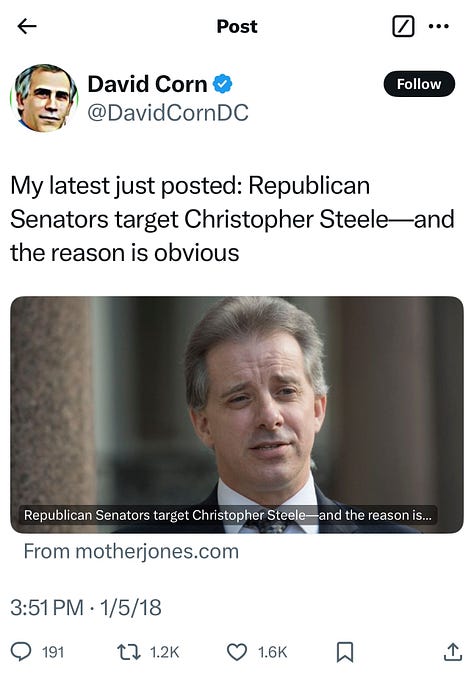
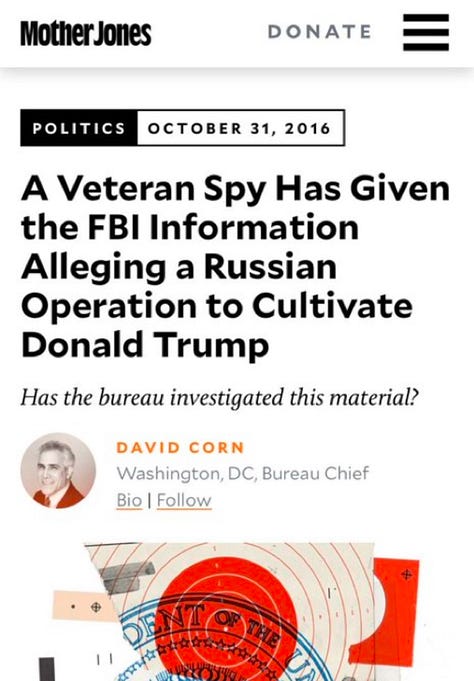
This is a real tweet from NBC News. Really.
But even that pales in comparison to ABC News, who made an entire film about Steele. Introing that with, “Some call him a hero…” is just *chef’s kiss*.
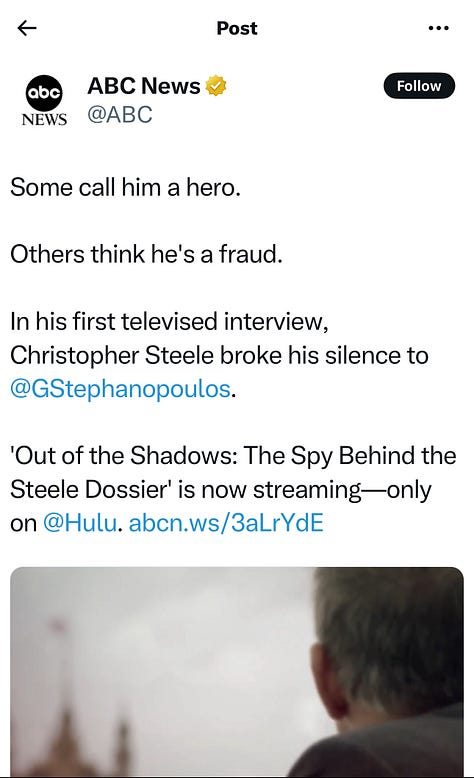
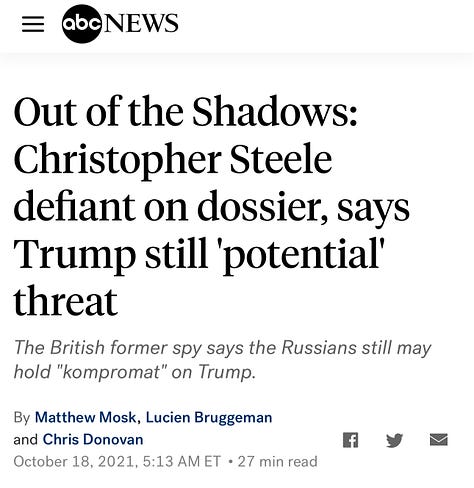
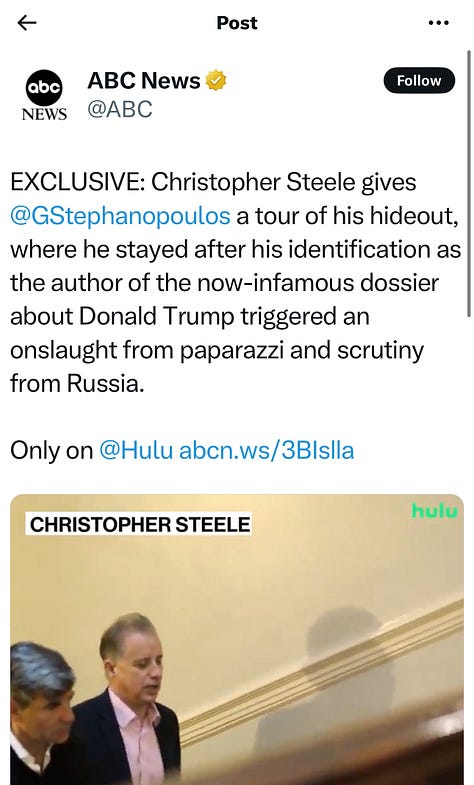
The suspense was always hanging around the dossier. The next shoe was ever about to drop. Here’s Newsweek.
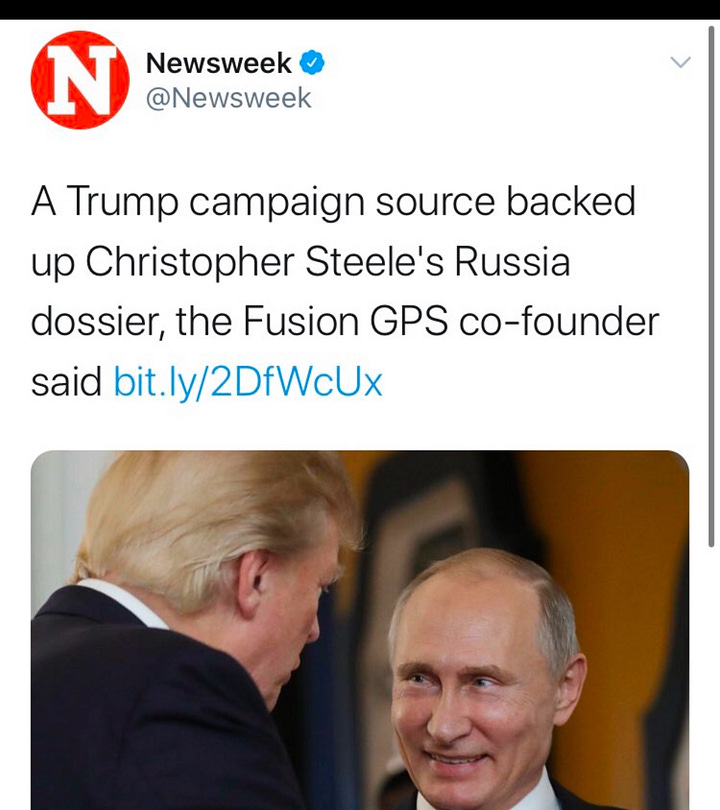
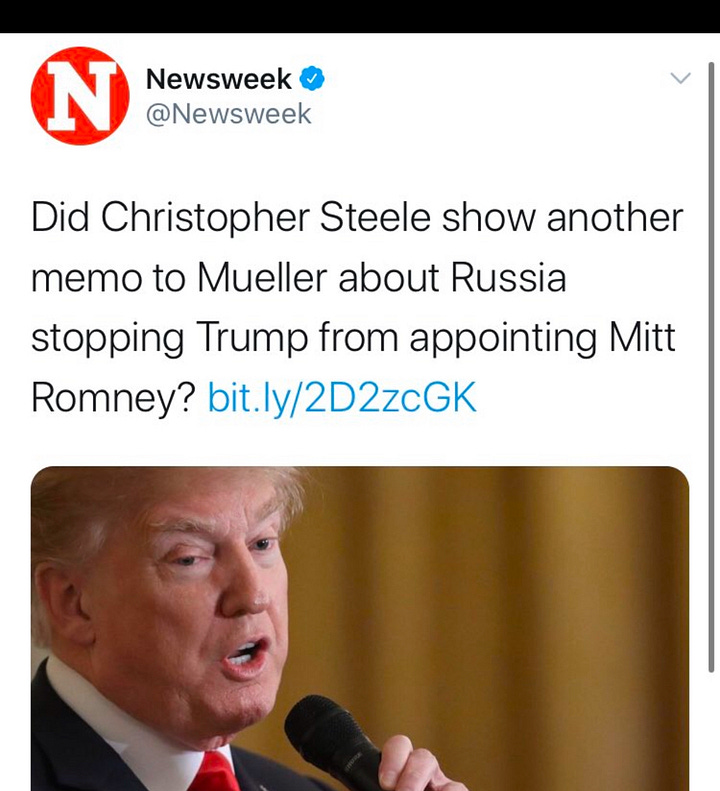
Ditto for Slate (my working theory is that Slate is in fact a conservative psy-op).
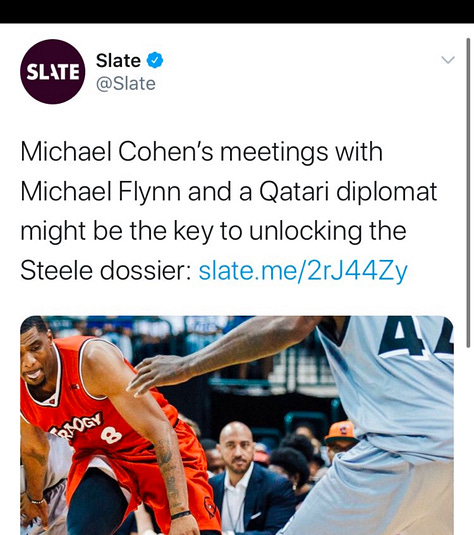
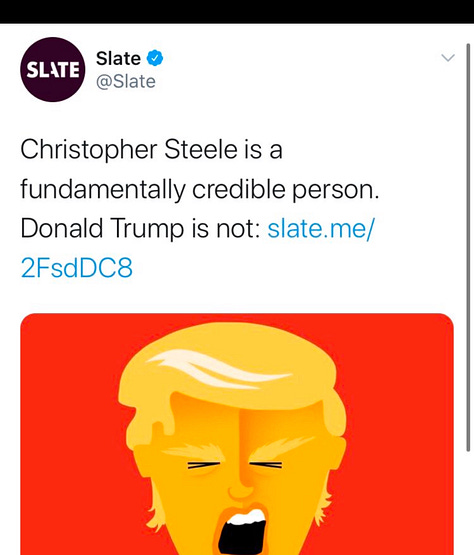

Gaining traction because of whom, CBS News? The media perhaps?
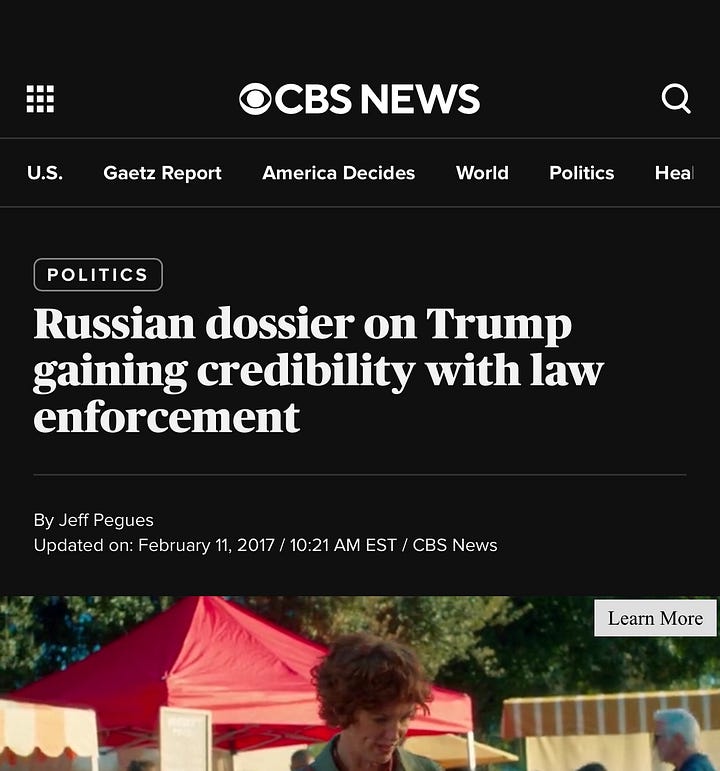
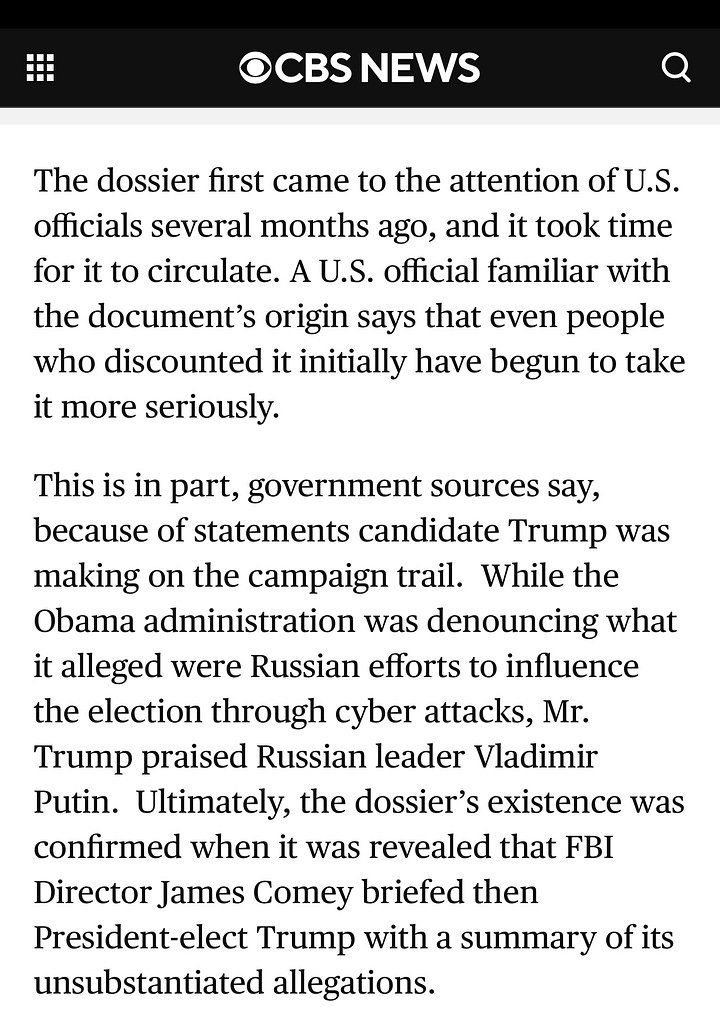
Look, every outlet really did seem to do this. I’ve only got so man y words for each one. Here’s CNBC.

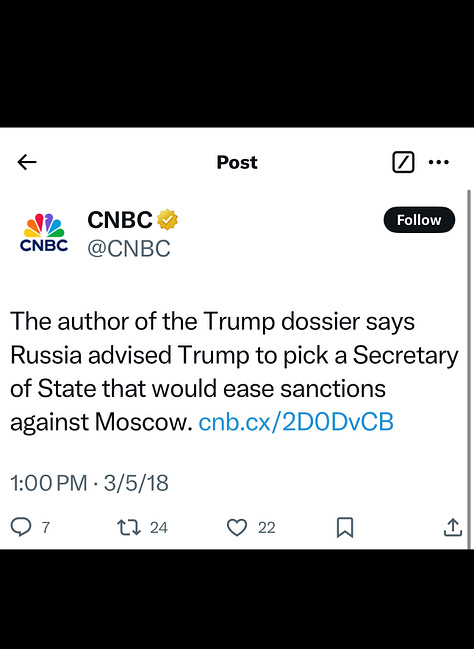
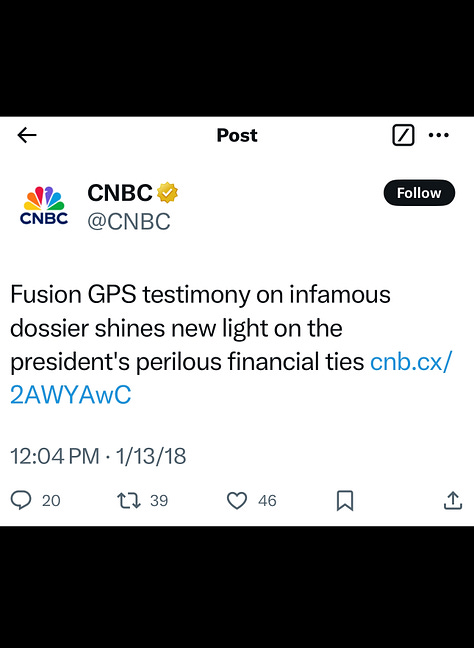
I try to avoid singling out people in these retrospectives, but there were a few Twitter blue-checks who really played leading roles in promoting the conspiracy theories contained within the Steele dossier.
As ever, former Washington Post columnist Jennifer Rubin helped lead the charge
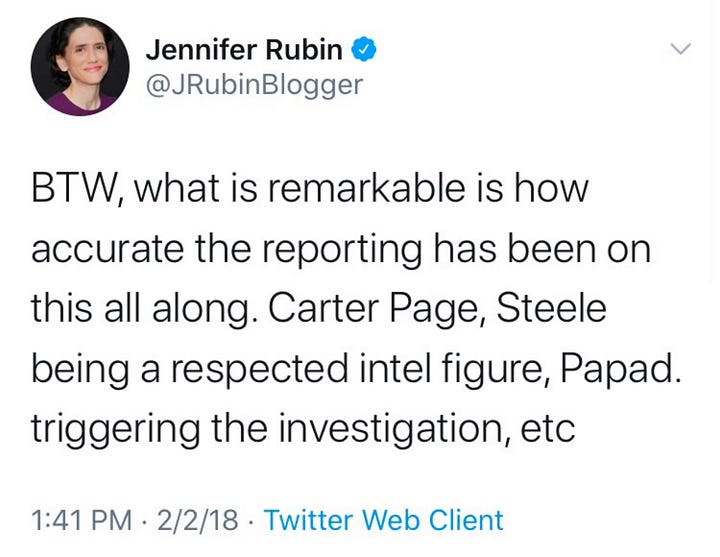
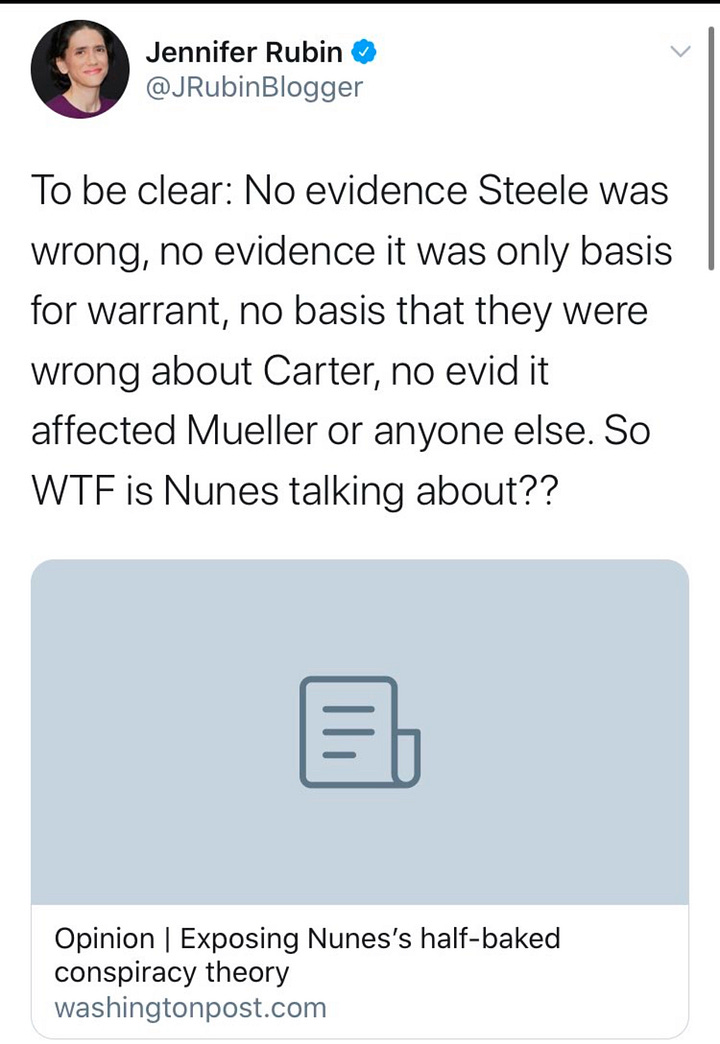
And often-wrong internet lawyer Laurence Tribe was incessant about this. I wonder if he would care to revisit?
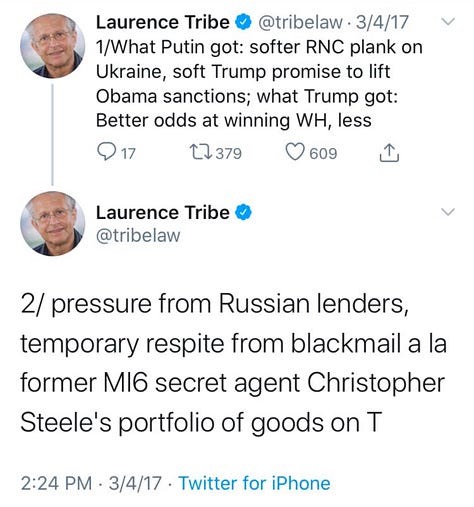
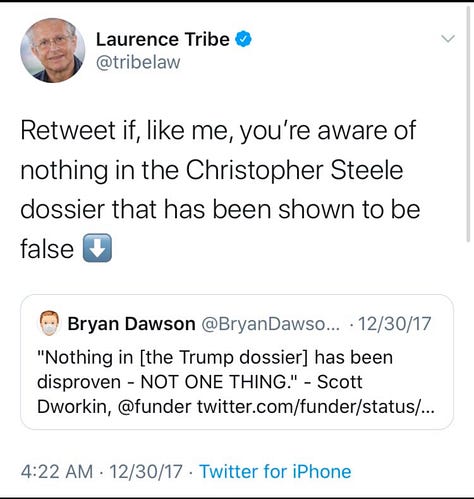
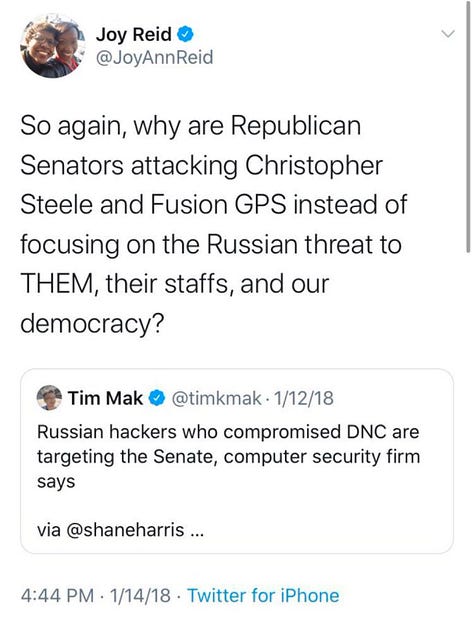
Don’t forget Max Boot and Jonathan Chait.
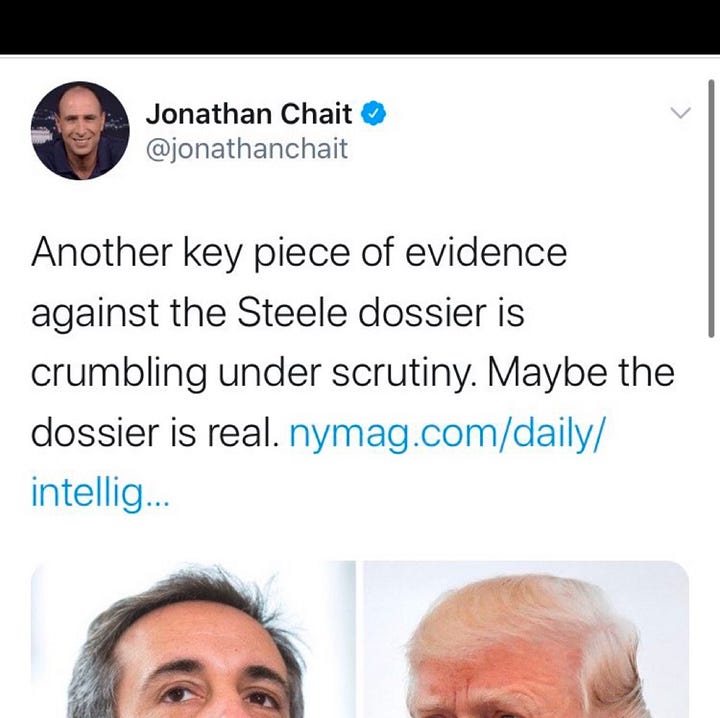
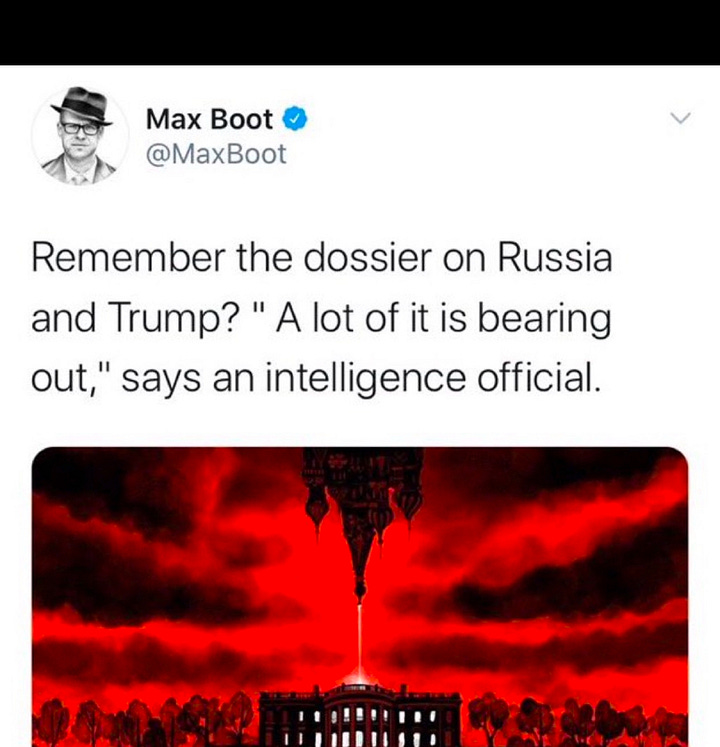
The facts:
All of that in an attempt to push a document that even the New York Times now calls “discredited.”
The dossier imploded in what felt like the blink of an eye, after sustaining a couple of body blows to its credibility between 2017-2019. A pair of federal investigations not only failed to corroborate the underlying claims, but revealed that the FBI had lied to Congress about the Steele dossier’s reliability. Despite offering $1 million to Steele to verify his allegations, he couldn’t. The FBI pushed ahead anyway. Then, a key source for Steele, Igor Danchenko, was indicted for lying to the FBI, and more scrutiny was applied to Steele’s other sources, collapsing the house of cards even for the corporate press.
Even CNN put out a piece trying to explain how they had been duped, with an attempt at a mea culpa for having done so. It paralleled the broader collapse of the “Russian collusion” narrative, as Americans seemingly broke from the Russian-agent fever that had possessed it.
For a full breakdown of how the dossier came undone, read the Washington Post’s Erik Wemple’s exemplary series on the coverage of it, where he held the media to account in real time. The below sums up much of it quite well. (And if you read the whole thing, you’ll even catch a mention of your author.)
The takeaway:
The Russia story that the Steele dossier helped birth dominated Trump’s first term, sucking the energy out of Washington, and grinding his legislative agenda to a halt. By the time special counsel Robert Mueller’s investigation intro Trump’s alleged ties to Russia concluded in 2019, his first term was more than halfway finished. It’s hard to overstate the media’s impact in scuttling those years.
Perhaps most consequentially, the saga revealed the power of the media to turn something baseless but explosive into a political weapon against their opponents — even against a Republican president. It would be repeated, again and again, in the years that followed. The resulting damage to America’s body politic — and the media’s reputation among anyone who isn’t a committed Democrat — is hard to overstate, too.
And it’s almost impossibly rich coming from the same media who obsess over the supposed danger of misinformation, disinformation, and conspiracy theories — at least when they’re promulgated by the other side. What else could you call this?
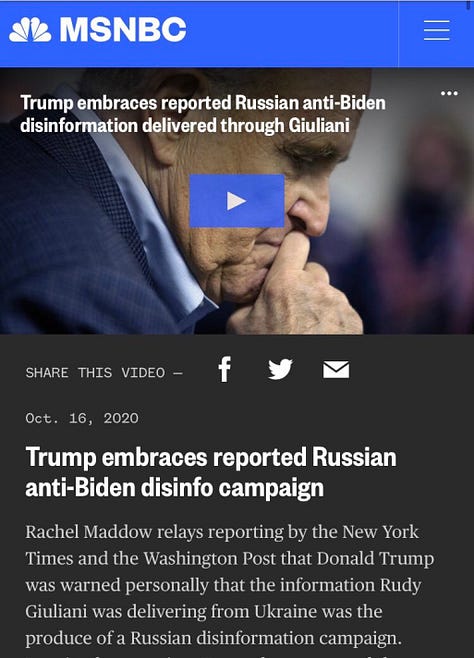
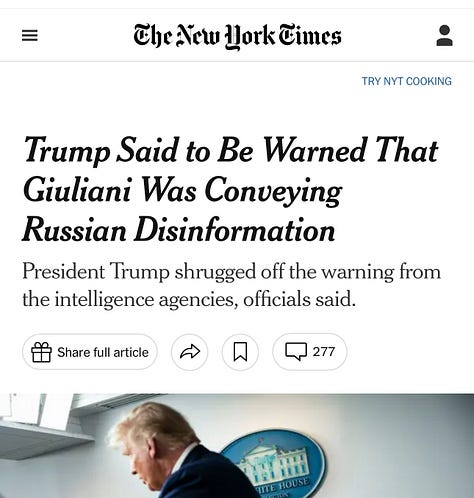
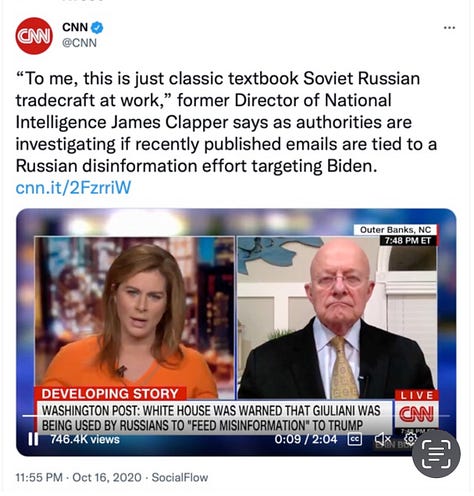
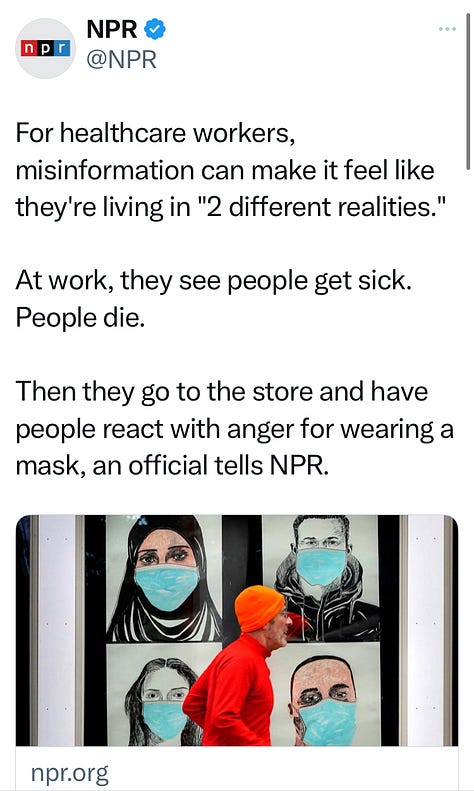
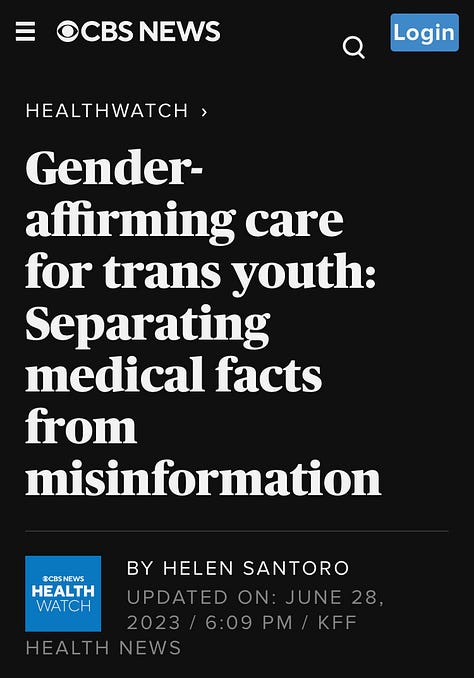
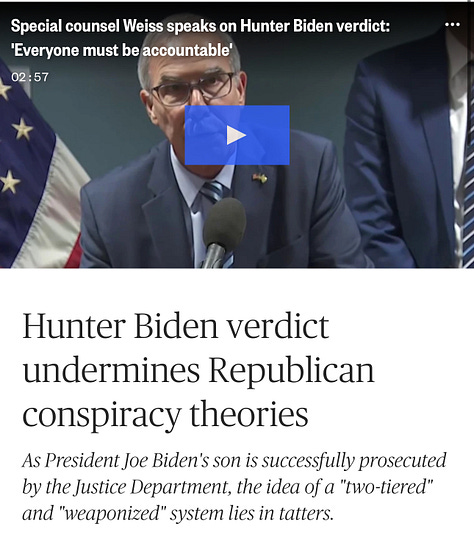
If advancing dubious claims is so horrible, so threatening to the well-being of America and Americans, how can the media defend their promotion of the Steele dossier? How could they push dramatic, unverified allegations against the president as if they were fact?
Good luck squaring that circle.


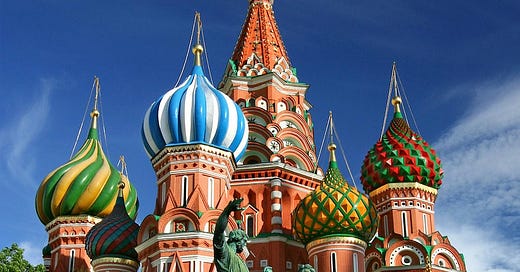


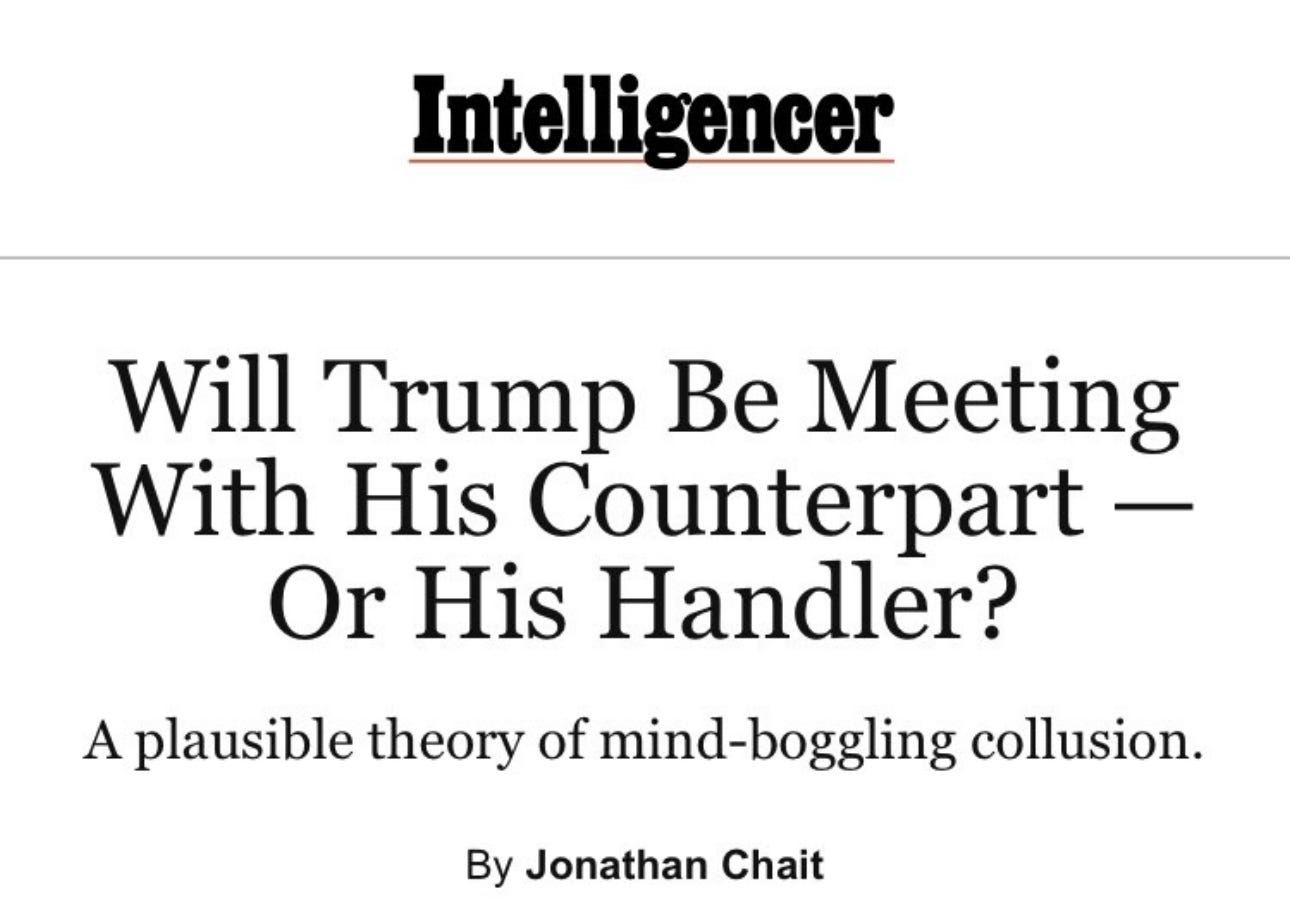
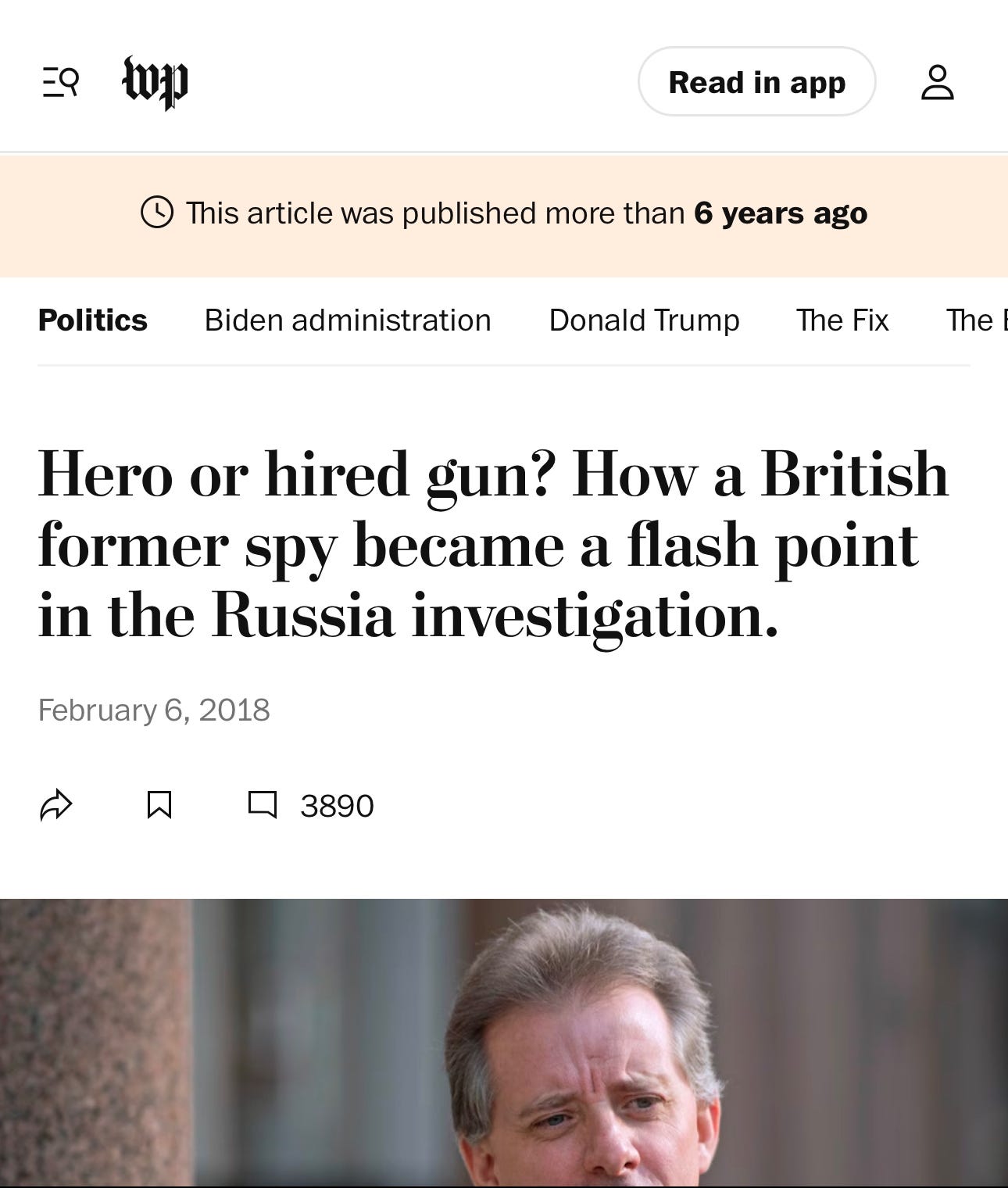
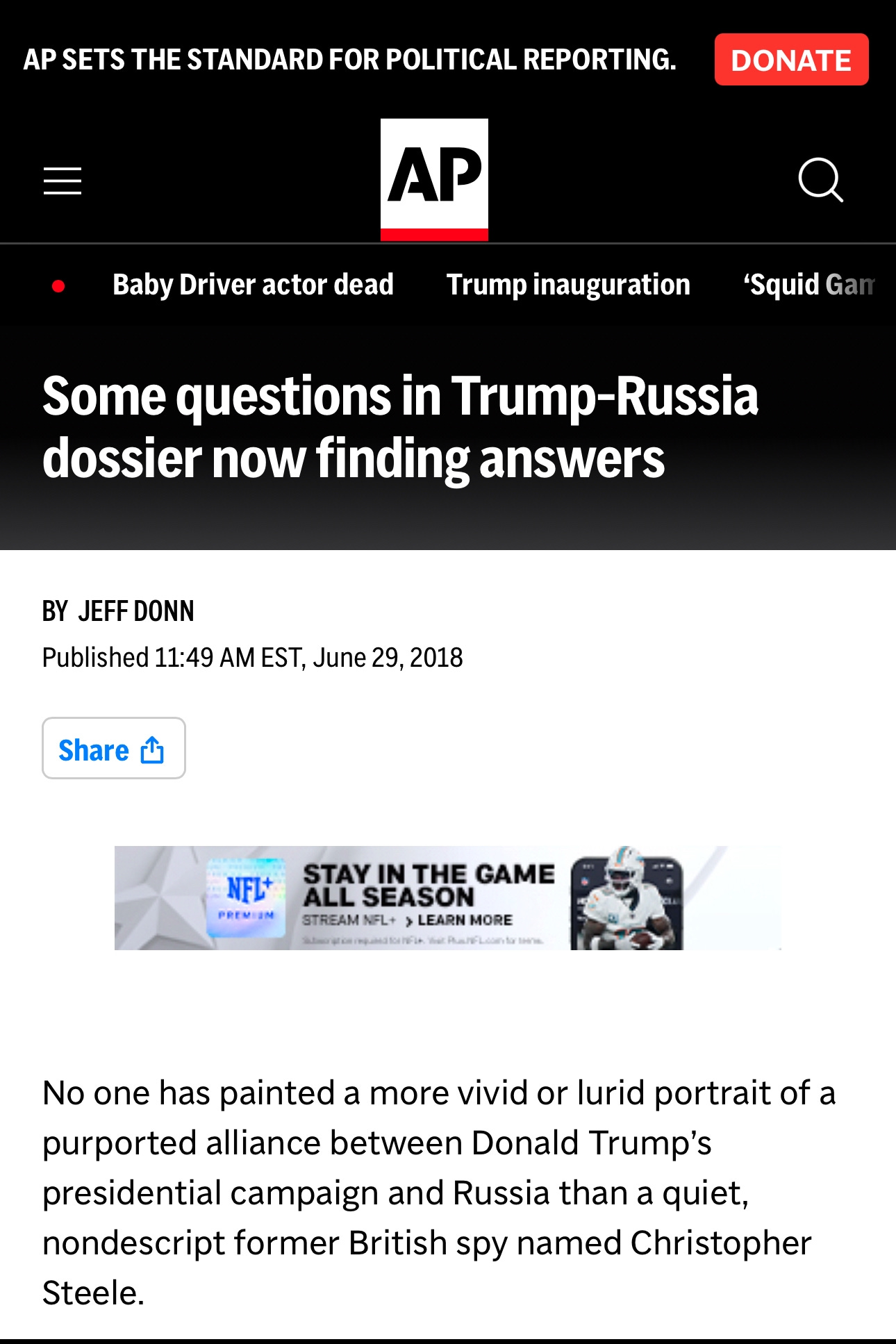
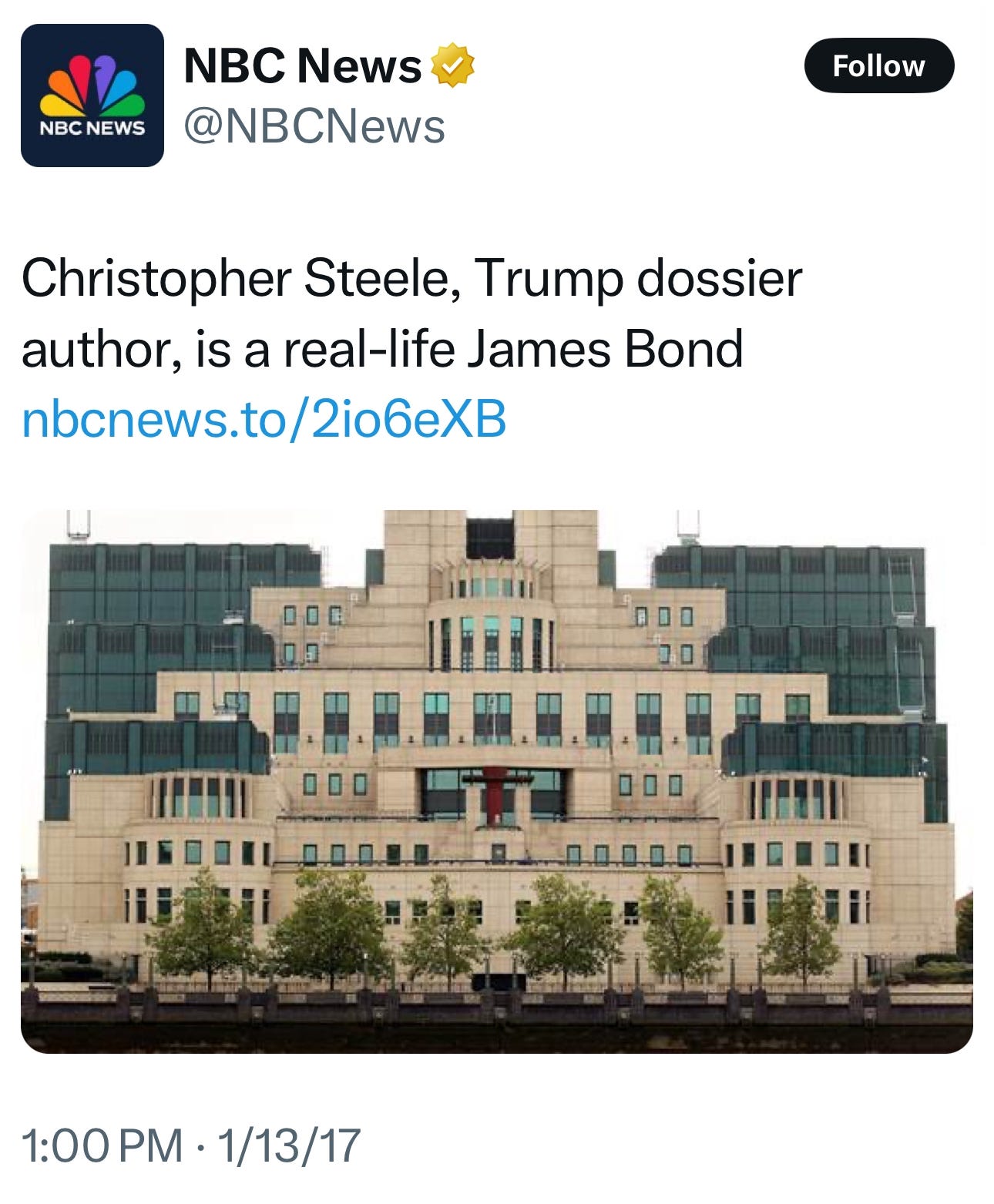
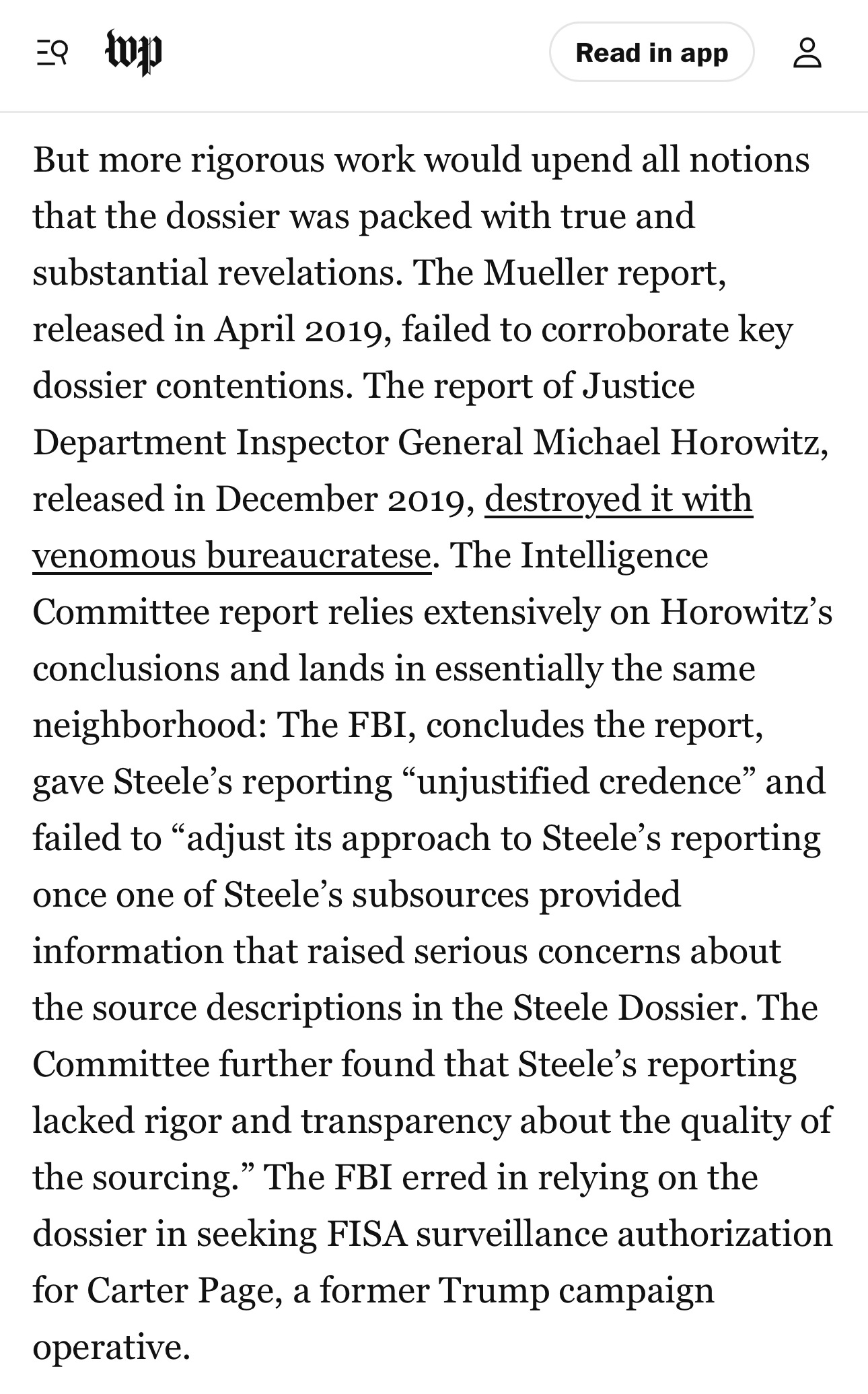
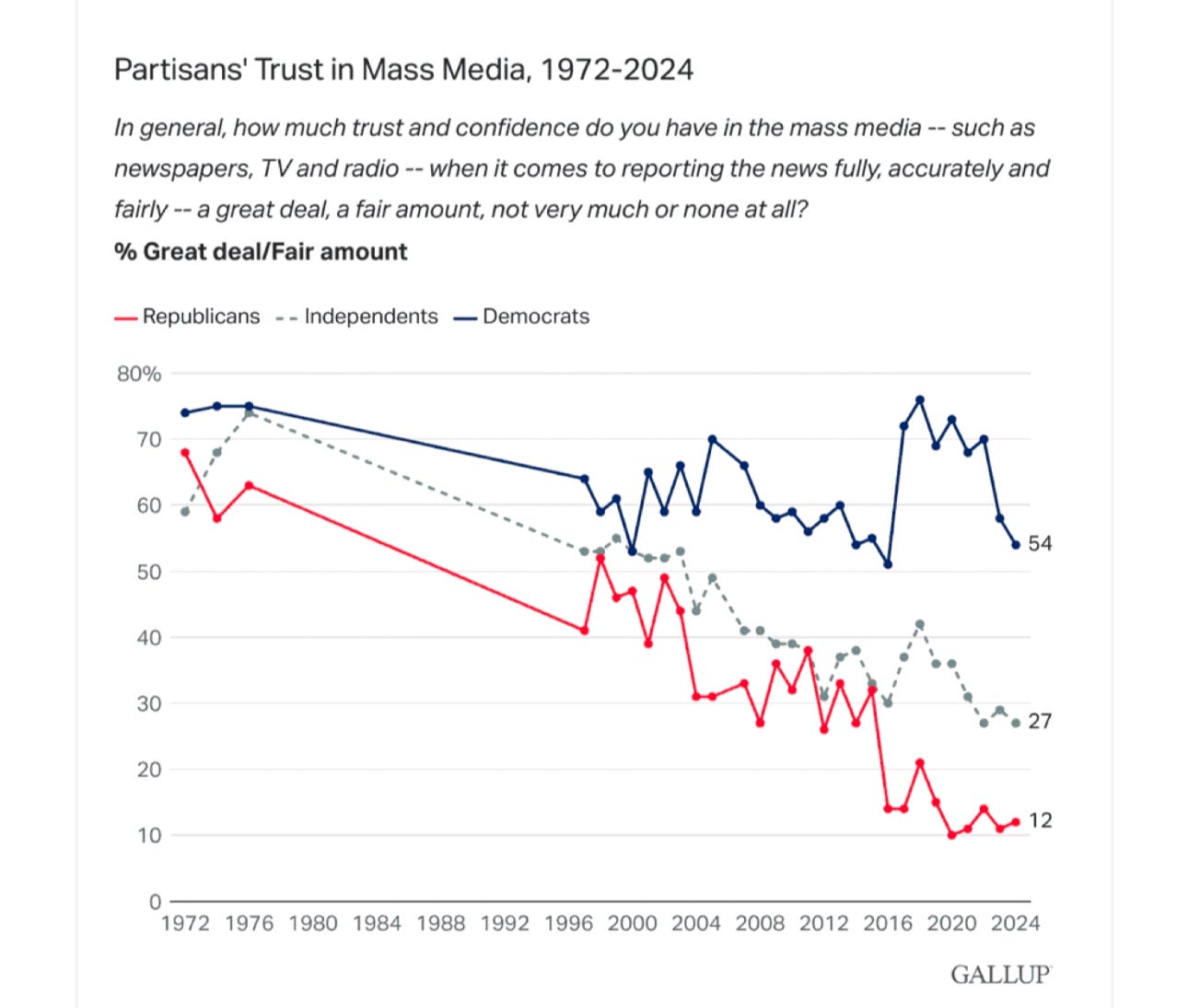
Phenomenon work, as always Drew. Thank you.
This was a British plot, aided and abetted by British media figures in America including the CEO of the NY Times, Mark Thompson. When it failed, they turned to plan B, the Skripal psy-op.